
| Three Months Ended 30 June | ||||||||||||||||
| 2005 | 2004 | |||||||||||||||
| Key Information | US$M | US$M | Movement | |||||||||||||
Net Sales From Ordinary Activities |
359.4 | 306.1 | up | 17 | % | |||||||||||
Operating Profit From Continuing Operations After Tax
Attributable to Shareholders |
55.9 | 37.1 | up | 51 | % | |||||||||||
Operating Profit including Discontinued Operations
Attributable to Shareholders |
55.9 | 36.3 | up | 54 | % | |||||||||||
Net Tangible Assets per Ordinary Share |
US$ | 1.42 | US$ | 1.12 | up | 27 | % | |||||||||
| 1. | Media Release | ||
| 2. | Results At A Glance | ||
| 3. | Management’s Analysis of Results | ||
| 4. | Consolidated Financial Statements | ||
| 5. | Management Presentation |
| Analyst and Media enquiries about results, | ||
| please contact Steve Ashe on | ||
| Tel: 61 2 8274 5246 Mob: 0408 164 011 |
| US$ Million | Q1FY06 | Q1FY05 | %+\(-) | |||||||||
Net Sales |
$ | 359.4 | $ | 306.1 | 17 | |||||||
Gross Profit |
145.3 | 111.3 | 31 | |||||||||
Special Commission of Inquiry and other related expenses |
(5.2 | ) | (2.9 | ) | 79 | |||||||
Impairment loss on business held for sale |
(1.4 | ) | — | — | ||||||||
EBIT |
86.9 | 58.3 | 49 | |||||||||
Net Interest Expense |
(0.7 | ) | (2.5 | ) | (72 | ) | ||||||
Income Tax Expense |
(30.3 | ) | (18.7 | ) | 62 | |||||||
Operating Profit from continuing operations |
55.9 | 37.1 | 51 | |||||||||
Net Operating Profit including discontinued operations |
55.9 | 36.3 | 54 | |||||||||
2
3
| 1 | Range includes forecasts by research equity analysts from: ABN Amro, Deutsche, JPMorgan, Merrill Lynch, Goldman Sachs JBWere, UBS, Citigroup, CSFB, Morgan Stanley and Macquarie Research. |
4
| • | projections of our operating results or financial condition; | ||
| • | statements regarding our plans, objectives or goals, including those relating to competition, acquisitions, dispositions and our products; | ||
| • | statements about our future performance; | ||
| • | statements about product or environmental liabilities; and | ||
| • | expectations about payments to a special purpose fund for the compensation of proven asbestos-related personal injury and death claims. |
5
| US$Millions | Q1 FY06 | |||||||||||||||
James Hardie |
||||||||||||||||
Net Sales |
Up | 17 | % | to | US$ | 359.4 | ||||||||||
EBIT |
Up | 49 | % | to | US$ | 86.9 | ||||||||||
Operating Profit from
Continuing Operations |
Up | 51 | % | to | US$ | 55.9 | ||||||||||
Net Operating Profit Including
Discontinued Operations |
Up | 54 | % | to | US$ | 55.9 | ||||||||||
EBIT Margin |
Up | 4.9pts | to | 24.1 | % | |||||||||||
USA Fibre Cement |
||||||||||||||||
Net Sales |
Up | 19 | % | to | US$ | 287.5 | ||||||||||
EBIT |
Up | 49 | % | to | US$ | 94.1 | ||||||||||
EBIT Margin |
Up | 6.5pts | to | 32.7 | % | |||||||||||
Volume |
Up | 7 | % | to | 523.4 mmsf | |||||||||||
Asia Pacific Fibre Cement |
||||||||||||||||
Net Sales |
Up | 8 | % | to | US$ | 61.7 | ||||||||||
EBIT |
Up | 3 | % | to | US$ | 12.4 | ||||||||||
EBIT Margin |
Down | 0.8pts | to | 20.1 | % | |||||||||||
Volume |
Down | 2 | % | to | 92.0 mmsf | |||||||||||
Key Ratios |
||||||||||||||||
Earnings Per Share (Diluted) |
12.1cents | |||||||||||||||
EBIT Margin |
24.1 | % | ||||||||||||||
| Return on Shareholders Funds (Annualised — including discontinued operations) | 38.5 | % | ||||||||||||||
| Return on Capital Employed (Annualised) | 39.9 | % | ||||||||||||||
Gearing Ratio |
(0.2 | )% | ||||||||||||||
Net Interest Expense Cover |
131.3x | |||||||||||||||
Net Debt Payback |
(0.2)months | |||||||||||||||
1
2
| Three Months Ended 30 June | ||||||||||||
| US GAAP - US$ Millions | FY 2006 | FY 2005 | % Change | |||||||||
Net Sales |
||||||||||||
USA Fibre Cement |
$ | 287.5 | $ | 240.7 | 19 | |||||||
Asia Pacific Fibre Cement |
61.7 | 57.3 | 8 | |||||||||
Other Fibre Cement |
10.2 | 8.1 | 26 | |||||||||
Total Net Sales |
359.4 | 306.1 | 17 | |||||||||
Cost of goods sold |
(214.1 | ) | (194.8 | ) | 10 | |||||||
Gross profit |
145.3 | 111.3 | 31 | |||||||||
Selling, general and administrative expenses |
(45.5 | ) | (45.1 | ) | 1 | |||||||
Research and development expenses |
(6.3 | ) | (5.0 | ) | 26 | |||||||
Special Commission of Inquiry and other related expenses |
(5.2 | ) | (2.9 | ) | 79 | |||||||
Impairment loss on business held for sale |
(1.4 | ) | — | — | ||||||||
EBIT |
86.9 | 58.3 | 49 | |||||||||
Net interest expense |
(0.7 | ) | (2.5 | ) | (72 | ) | ||||||
Operating profit from continuing operations before
income taxes |
86.2 | 55.8 | 54 | |||||||||
Income tax expense |
(30.3 | ) | (18.7 | ) | 62 | |||||||
Operating Profit From Continuing Operations |
$ | 55.9 | $ | 37.1 | 51 | |||||||
Net Operating Profit Including Discontinued Operations |
$ | 55.9 | $ | 36.3 | 54 | |||||||
Tax rate |
35.2 | % | 33.5 | % | ||||||||
Volume (mmsf) |
||||||||||||
USA Fibre Cement |
523.4 | 490.4 | 7 | |||||||||
Asia Pacific Fibre Cement |
92.0 | 94.2 | (2 | ) | ||||||||
Average net sales price per unit (per msf) |
||||||||||||
USA Fibre Cement |
US$ | 549 | US$ | 491 | 12 | |||||||
Asia Pacific Fibre Cement |
A$ | 873 | A$ | 851 | 3 | |||||||
2
3
4
5
| Effective Interest | Principal | |||||||||||
| Rate at | Total Facility at | Outstanding at | ||||||||||
| Description | 30 June 2005 | 30 June 2005 | 30 June 2005 | |||||||||
| (US$ millions) | ||||||||||||
US$ notes, fixed
interest, repayable
annually in varying
tranches from
November 2005
through November
2013 |
7.12 | % | $ | 147.4 | $ | 147.4 | ||||||
US$364-day
Facility, can be
drawn in US$,
variable interest
rates based on
LIBOR plus margin,
can be repaid and
redrawn until
maturity in June
2006 |
N/A | 355.0 | — | |||||||||
US$ line of credit,
can be drawn down
in Chilean Pesos,
variable interest
based on Chilean
Tasa Activa
Bancaria rate plus
margin until
maturity in March
2006 1 |
5.11 | % | 15.0 | 12.7 | ||||||||
Total |
$ | 517.4 | $ | 160.1 | ||||||||
6
7
8
| • | projections of our operating results or financial condition; | ||
| • | statements regarding our plans, objectives or goals, including those relating to competition, acquisitions, dispositions and our products; | ||
| • | statements about our future performance; | ||
| • | statements about product or environmental liabilities; and | ||
| • | expectations about payments to a special purpose fund for the compensation of proven asbestos-related personal injury and death claims. |
9
| Page | ||||
Item 1. Financial Statements (Unaudited) |
||||
Consolidated Balance Sheets as of 30 June 2005 and 31 March 2005 |
F-2 | |||
Consolidated Statements of Income for the Three Months Ended 30 June 2005 and
2004 |
F-3 | |||
Consolidated Statements of Cash Flows for the Three Months Ended 30 June
2005 and 2004 |
F-5 | |||
Consolidated Statements of Changes in Shareholders’ Equity for the Three
Months Ended 30 June 2005 |
F-7 | |||
Notes to Consolidated Financial Statements |
F-8 | |||
Item 2. Quantitative and Qualitative Disclosures About Market Risk |
F-30 | |||
| Millions of | Millions of | |||||||||||||||
| US Dollars | Australian Dollars | |||||||||||||||
| 30 June | 31 March | 30 June | 31 March | |||||||||||||
| 2005 | 2005 | 2005 | 2005 | |||||||||||||
Assets |
||||||||||||||||
Current assets: |
||||||||||||||||
Cash and cash equivalents |
$ | 161.6 | $ | 113.5 | A$ | 211.6 | A$ | 146.9 | ||||||||
Accounts and notes receivable, net of allowance
for doubtful accounts of $1.5 million (A$2.0
million) and $1.5 million (A$1.8 million) as of
30 June 2005 and 31 March 2005, respectively |
139.0 | 122.8 | 182.0 | 159.0 | ||||||||||||
Inventories |
104.1 | 98.6 | 136.3 | 127.6 | ||||||||||||
Prepaid expenses and other current assets |
18.7 | 12.0 | 24.5 | 15.5 | ||||||||||||
Deferred tax assets |
21.0 | 25.8 | 27.5 | 33.4 | ||||||||||||
Assets of business held for sale |
17.0 | 17.9 | 22.3 | 23.2 | ||||||||||||
Total current assets |
461.4 | 390.6 | 604.2 | 505.6 | ||||||||||||
Property, plant and equipment, net |
700.6 | 677.6 | 917.2 | 877.2 | ||||||||||||
Deferred tax assets |
10.8 | 10.6 | 14.1 | 13.7 | ||||||||||||
Other assets |
9.7 | 10.1 | 12.7 | 13.1 | ||||||||||||
Total assets |
$ | 1,182.5 | $ | 1,088.9 | A$ | 1,548.2 | A$ | 1,409.6 | ||||||||
Liabilities and Shareholders’ Equity |
||||||||||||||||
Current liabilities: |
||||||||||||||||
Accounts payable and accrued liabilities |
$ | 104.3 | $ | 92.1 | A$ | 136.5 | A$ | 119.2 | ||||||||
Current portion of long-term debt |
25.7 | 25.7 | 33.6 | 33.3 | ||||||||||||
Dividends payable |
27.5 | — | 36.0 | — | ||||||||||||
Accrued payroll and employee benefits |
24.2 | 35.4 | 31.7 | 45.8 | ||||||||||||
Accrued product warranties |
8.6 | 8.0 | 11.3 | 10.4 | ||||||||||||
Income taxes payable |
47.3 | 21.4 | 61.9 | 27.7 | ||||||||||||
Other liabilities |
1.7 | 1.5 | 2.2 | 1.9 | ||||||||||||
Liabilities of business held for sale |
15.0 | 14.3 | 19.6 | 18.5 | ||||||||||||
Total current liabilities |
254.3 | 198.4 | 332.8 | 256.8 | ||||||||||||
Long-term debt |
121.7 | 121.7 | 159.3 | 157.6 | ||||||||||||
Deferred income taxes |
80.4 | 77.5 | 105.3 | 100.3 | ||||||||||||
Accrued product warranties |
4.4 | 4.9 | 5.8 | 6.3 | ||||||||||||
Other liabilities |
63.0 | 61.7 | 82.5 | 79.9 | ||||||||||||
Total liabilities |
523.8 | 464.2 | 685.7 | 600.9 | ||||||||||||
Commitments and contingencies (Note 8) |
||||||||||||||||
Shareholders’ equity: |
||||||||||||||||
Common stock, Euro 0.59 par value, 2.0 billion
shares authorised; 461,021,588 shares issued
and outstanding at 30 June 2005 and
459,373,176 shares issued and outstanding
at 31 March 2005 |
247.1 | 245.8 | ||||||||||||||
Additional paid-in capital |
144.3 | 139.4 | ||||||||||||||
Retained earnings |
292.7 | 264.3 | ||||||||||||||
Employee loans |
(0.6 | ) | (0.7 | ) | ||||||||||||
Accumulated other comprehensive loss |
(24.8 | ) | (24.1 | ) | ||||||||||||
Total shareholders’ equity |
658.7 | 624.7 | ||||||||||||||
Total liabilities and shareholders’ equity |
$ | 1,182.5 | $ | 1,088.9 | ||||||||||||
F-2
| Three Months | ||||||||
| Ended 30 June | ||||||||
| (Millions of US dollars, except per share data) | 2005 | 2004 | ||||||
Net sales |
$ | 359.4 | $ | 306.1 | ||||
Cost of goods sold |
(214.1 | ) | (194.8 | ) | ||||
Gross profit |
145.3 | 111.3 | ||||||
Selling, general and administrative expenses |
(45.5 | ) | (45.1 | ) | ||||
Research and development expenses |
(6.3 | ) | (5.0 | ) | ||||
SCI and other related expenses |
(5.2 | ) | (2.9 | ) | ||||
Impairment loss on business held for sale |
(1.4 | ) | — | |||||
Operating income |
86.9 | 58.3 | ||||||
Interest expense |
(1.7 | ) | (2.8 | ) | ||||
Interest income |
1.0 | 0.3 | ||||||
Income from continuing operations
before income taxes |
86.2 | 55.8 | ||||||
Income tax expense |
(30.3 | ) | (18.7 | ) | ||||
Income from continuing operations |
55.9 | 37.1 | ||||||
Loss on disposal of discontinued operations
net of income tax of nil |
— | (0.8 | ) | |||||
Net income |
$ | 55.9 | $ | 36.3 | ||||
Income per share — basic: |
||||||||
Income from continuing operations |
$ | 0.12 | $ | 0.08 | ||||
Loss from discontinued operations |
— | — | ||||||
Net income per share — basic |
$ | 0.12 | $ | 0.08 | ||||
Income per share — diluted: |
||||||||
Income from continuing operations |
$ | 0.12 | $ | 0.08 | ||||
Loss from discontinued operations |
— | — | ||||||
Net income per share — diluted |
$ | 0.12 | $ | 0.08 | ||||
Weighted average common shares outstanding |
||||||||
(Millions): |
||||||||
Basic |
460.6 | 458.6 | ||||||
Diluted |
462.7 | 460.8 | ||||||
F-3
| Three Months | ||||||||
| Ended 30 June | ||||||||
| (Millions of Australian dollars, except per share data) | 2005 | 2004 | ||||||
Net sales |
A$ | 467.6 | A$ | 428.4 | ||||
Cost of goods sold |
(278.5 | ) | (272.6 | ) | ||||
Gross profit |
189.1 | 155.8 | ||||||
Selling, general and administrative expenses |
(59.2 | ) | (63.1 | ) | ||||
Research and development expenses |
(8.2 | ) | (7.0 | ) | ||||
SCI and other related expenses |
(6.8 | ) | (4.0 | ) | ||||
Impairment loss on business held for sale |
(1.8 | ) | — | |||||
Operating income |
113.1 | 81.7 | ||||||
Interest expense |
(2.2 | ) | (3.9 | ) | ||||
Interest income |
1.3 | 0.4 | ||||||
Income from continuing operations
before income taxes |
112.2 | 78.2 | ||||||
Income tax expense |
(39.4 | ) | (26.2 | ) | ||||
Income from continuing operations |
72.8 | 52.0 | ||||||
Loss on disposal of discontinued operations
net of income tax of nil |
— | (1.1 | ) | |||||
Net income |
A$ | 72.8 | A$ | 50.9 | ||||
Income per share — basic: |
||||||||
Income from continuing operations |
A$ | 0.16 | A$ | 0.11 | ||||
Loss from discontinued operations |
— | — | ||||||
Net income per share — basic |
A$ | 0.16 | A$ | 0.11 | ||||
Income per share — diluted: |
||||||||
Income from continuing operations |
A$ | 0.16 | A$ | 0.11 | ||||
Loss from discontinued operations |
— | — | ||||||
Net income per share — diluted |
A$ | 0.16 | A$ | 0.11 | ||||
Weighted average common shares outstanding |
||||||||
(Millions): |
||||||||
Basic |
460.6 | 458.6 | ||||||
Diluted |
462.7 | 460.8 | ||||||
F-4
| Three Months | ||||||||
| Ended 30 June | ||||||||
| (Millions of US dollars) | 2005 | 2004 | ||||||
Cash Flows From Operating Activities |
||||||||
Net income |
$ | 55.9 | $ | 36.3 | ||||
Adjustments to reconcile net income to net cash
provided by operating activities: |
||||||||
Impairment loss on business held for sale |
1.4 | — | ||||||
Depreciation and amortisation |
9.4 | 8.9 | ||||||
Deferred income taxes |
7.3 | (0.8 | ) | |||||
Prepaid pension cost |
0.8 | 0.7 | ||||||
Tax benefit from stock options exercised |
0.6 | — | ||||||
Stock compensation |
1.0 | 0.7 | ||||||
Other |
0.3 | — | ||||||
Changes in operating assets and liabilities: |
||||||||
Accounts receivable |
(16.2 | ) | (2.3 | ) | ||||
Inventories |
(6.4 | ) | 9.7 | |||||
Prepaid expenses and other current assets |
(7.4 | ) | 32.3 | |||||
Accounts payable and accrued liabilities |
12.4 | 9.3 | ||||||
Other accrued liabilities and other liabilities |
18.1 | (23.8 | ) | |||||
Net cash provided by operating activities |
77.2 | 71.0 | ||||||
Cash Flows From Investing Activities |
||||||||
Purchases of property, plant and equipment |
(34.0 | ) | (30.3 | ) | ||||
Collections on loans receivable |
0.1 | — | ||||||
Net cash used in investing activities |
(33.9 | ) | (30.3 | ) | ||||
Cash Flows From Financing Activities |
||||||||
Net proceeds from line of credit |
0.6 | — | ||||||
Proceeds from issuance of shares |
4.6 | 0.4 | ||||||
Net cash provided by financing activities |
5.2 | 0.4 | ||||||
Effects of exchange rate changes on cash |
(0.4 | ) | (0.5 | ) | ||||
Net increase in cash and cash equivalents |
48.1 | 40.6 | ||||||
Cash and cash equivalents at beginning of period |
113.5 | 72.3 | ||||||
Cash and cash equivalents at end of period |
161.6 | 112.9 | ||||||
Components of Cash and Cash Equivalents |
||||||||
Cash at bank and on hand |
53.5 | 25.7 | ||||||
Short-term deposits |
108.1 | 87.2 | ||||||
Cash and cash equivalents at end of period |
$ | 161.6 | $ | 112.9 | ||||
F-5
| Three Months | ||||||||
| Ended 30 June | ||||||||
| (Millions of Australian dollars) | 2005 | 2004 | ||||||
Cash Flows From Operating Activities |
||||||||
Net income |
A$ | 72.8 | A$ | 50.9 | ||||
Adjustments to reconcile net income to net cash
provided by operating activities: |
||||||||
Impairment loss on business held for sale |
1.8 | — | ||||||
Depreciation and amortisation |
12.2 | 12.5 | ||||||
Deferred income taxes |
9.5 | (1.1 | ) | |||||
Prepaid pension cost |
1.0 | 1.0 | ||||||
Tax benefit from stock options exercised |
0.8 | — | ||||||
Stock compensation |
1.3 | 1.0 | ||||||
Other |
0.4 | — | ||||||
Changes in operating assets and liabilities: |
||||||||
Accounts receivable |
(21.1 | ) | (3.2 | ) | ||||
Inventories |
(8.3 | ) | 13.6 | |||||
Prepaid expenses and other current assets |
(9.6 | ) | 45.2 | |||||
Accounts payable and accrued liabilities |
16.1 | 13.0 | ||||||
Other accrued liabilities and other liabilities |
23.5 | (33.3 | ) | |||||
Net cash provided by operating activities |
100.4 | 99.6 | ||||||
Cash Flows From Investing Activities |
||||||||
Purchases of property, plant and equipment |
(44.2 | ) | (42.4 | ) | ||||
Collections on loans receivable |
0.1 | — | ||||||
Net cash used in investing activities |
(44.1 | ) | (42.4 | ) | ||||
Cash Flows From Financing Activities |
||||||||
Net proceeds from line of credit |
0.8 | — | ||||||
Proceeds from issuance of shares |
6.0 | 0.6 | ||||||
Net cash provided by financing activities |
6.8 | 0.6 | ||||||
Effects of exchange rate changes on cash |
1.6 | 10.9 | ||||||
Net increase in cash and cash equivalents |
64.7 | 68.7 | ||||||
Cash and cash equivalents at beginning of period |
146.9 | 95.1 | ||||||
Cash and cash equivalents at end of period |
211.6 | 163.8 | ||||||
Components of Cash and Cash Equivalents |
||||||||
Cash at bank and on hand |
70.0 | 37.3 | ||||||
Short-term deposits |
141.6 | 126.5 | ||||||
Cash and cash equivalents at end of period |
A$ | 211.6 | A$ | 163.8 | ||||
F-6
| Accumulated | ||||||||||||||||||||||||
| Additional | Other | |||||||||||||||||||||||
| Common | Paid-in | Retained | Employee | Comprehensive | ||||||||||||||||||||
| (Millions of US dollars) | Stock | Capital | Earnings | Loans | Loss | Total | ||||||||||||||||||
Balances as of 31 March 2005 |
$ | 245.8 | $ | 139.4 | $ | 264.3 | $ | (0.7 | ) | $ | (24.1 | ) | $ | 624.7 | ||||||||||
Comprehensive income (loss): |
||||||||||||||||||||||||
Net income |
— | — | 55.9 | — | — | 55.9 | ||||||||||||||||||
Other comprehensive income (loss): |
||||||||||||||||||||||||
Amortisation of unrealised transition
loss on derivative instruments |
— | — | — | — | 0.3 | 0.3 | ||||||||||||||||||
Foreign currency translation loss |
— | — | — | — | (1.0 | ) | (1.0 | ) | ||||||||||||||||
Other comprehensive loss |
— | — | — | — | (0.7 | ) | (0.7 | ) | ||||||||||||||||
Total comprehensive income |
55.2 | |||||||||||||||||||||||
Dividends declared |
— | — | (27.5 | ) | — | — | (27.5 | ) | ||||||||||||||||
Stock compensation |
— | 1.0 | — | — | — | 1.0 | ||||||||||||||||||
Tax benefit from stock options exercised |
— | 0.6 | — | — | — | 0.6 | ||||||||||||||||||
Employee loans movement |
— | — | — | 0.1 | — | 0.1 | ||||||||||||||||||
Stock options exercised |
1.3 | 3.3 | — | — | — | 4.6 | ||||||||||||||||||
Balances as of 30 June 2005 |
$ | 247.1 | $ | 144.3 | $ | 292.7 | $ | (0.6 | ) | $ | (24.8 | ) | $ | 658.7 | ||||||||||
F-7
| 1. | Basis of Presentation | |
| The consolidated financial statements represent the financial position, results of operations and cash flows of James Hardie Industries N.V. (“JHI NV”) and its current wholly owned subsidiaries, collectively referred to as either the “Company” or “James Hardie” and JHI NV together with its subsidiaries as of the time relevant to the applicable reference, the “James Hardie Group,” unless the context indicates otherwise. | ||
| In the opinion of management, the accompanying consolidated financial statements reflect all adjustments, which are of a normal recurring nature, necessary for a fair statement of financial position as of 30 June and 31 March 2005 and the results of operations for the three months ended 30 June 2005 and 2004 and cash flows for the three months ended 30 June 2005 and 2004. These consolidated financial statements and notes are to be read in conjunction with the audited consolidated financial statements of James Hardie Industries N.V. and Subsidiaries for the three years ended 31 March 2005. The results of operations for the three months ended 30 June 2005 are not necessarily indicative of the results to be expected for the full fiscal year ending 31 March 2006. | ||
| Convenience Translation | ||
| As the majority of the Company’s shareholder base is Australian, the assets, liabilities, income statement and cash flows of the Company have been presented with accompanying Australian dollar (A$) convenience translations. These A$ convenience translations are not prepared in accordance with accounting principles generally accepted in the United States of America. The exchange rates used to calculate the convenience translations are as follows: |
| 31 March | 30 June | |||||||||||
| (US$1 = A$) | 2005 | 2005 | 2004 | |||||||||
Assets and liabilities |
1.2946 | 1.3092 | 1.4510 | |||||||||
Income statement |
n/a | 1.3010 | 1.3994 | |||||||||
Cash flows — beginning cash |
n/a | 1.2946 | 1.3156 | |||||||||
Cash flows — ending cash |
n/a | 1.3092 | 1.4510 | |||||||||
Cash flows — current period movements |
n/a | 1.3010 | 1.3994 | |||||||||
| 2. | Summary of Significant Accounting Policies | |
| Reclassifications | ||
| Certain prior year balances have been reclassified to conform with the current year presentation. |
F-8
| Earnings Per Share | ||
| The Company is required to disclose basic and diluted earnings per share (“EPS”). Basic EPS is calculated using income divided by the weighted average number of common shares outstanding during the period. Diluted EPS is similar to basic EPS except that the weighted average number of common shares outstanding is increased to include the number of additional common shares calculated using the treasury method that would have been outstanding if dilutive potential common shares, such as options, had been issued. Accordingly, basic and dilutive common shares outstanding used in determining net income per share are as follows: |
| Three Months | ||||||||
| Ended 30 June | ||||||||
| (Millions of shares) | 2005 | 2004 | ||||||
Basic common shares outstanding |
460.6 | 458.6 | ||||||
Dilutive effect of stock options |
2.1 | 2.2 | ||||||
Diluted common shares outstanding |
462.7 | 460.8 | ||||||
| (Continuing operations - US dollar) | 2005 | 2004 | ||||||
Net income per share — basic |
$ | 0.12 | $ | 0.08 | ||||
Net income per share — diluted |
$ | 0.12 | $ | 0.08 | ||||
| Potential common shares of 4.5 million and 9.3 million for the three months ended 30 June 2005 and 2004, respectively, have been excluded from the calculation of diluted common shares outstanding because the effect of their inclusion would be anti-dilutive. | ||
| Advertising | ||
| The Company expenses the production costs of advertising the first time the advertising takes place. Advertising expense was US$4.4 million and US$5.1 million for the three months ended 30 June 2005 and 2004, respectively. | ||
| Stock-Based Compensation | ||
| The Company estimates the fair value of its stock option grants on the date of grant using the Black-Scholes option-pricing model and recognises this value as compensation expense over the periods in which the options vest. Accordingly, the Company recognised stock-based compensation expense (included in selling, general and administrative expenses) of US$1.0 million and US$0.7 million for the three months ended 30 June 2005 and 2004, respectively. | ||
| Recent Accounting Pronouncements | ||
| Inventory Costs | ||
| In November 2004, the Financial Accounting Standards Board (“FASB”) issued Statement of Financial Accounting Standards (“SFAS”) No. 151, “Inventory Costs — an amendment of Accounting Research Bulletin (“ARB”) No. 43, Chapter 4.” SFAS No. 151 requires abnormal amounts of inventory costs related to idle facility, freight handling and wasted material expenses to be recognised as current period charges. Additionally, SFAS No. 151 requires that allocation of fixed production overhead to the costs of conversion be based on the normal capacity of the production facilities. SFAS No. 151 is effective for fiscal years beginning after 15 June 2005. The Company |
F-9
| does not expect the adoption of this standard to have a material impact on the Company’s consolidated financial statements. | ||
| American Jobs Creation Act | ||
| In October 2004, the President of the United States signed into law the American Jobs Creation Act (the “Act”). The Act allows for a US federal income tax deduction for a percentage of income earned from certain US production activities. Based on the effective date of the Act, the Company will be eligible for this deduction in the first quarter of fiscal year 2006. Additionally, in December 2004, the FASB issued FASB Staff Position (“FSP”) No. 109-1, “Application of FASB Statement No. 109, Accounting for Income Taxes (“SFAS No. 109”), to the Tax Deduction on Qualified Production Activities Provided by the American Jobs Creation Act of 2004.” FSP No. 109-1, which was effective upon issuance, states the deduction under this provision of the Act should be accounted for as a special deduction in accordance with SFAS No 109. The Company applied the guidance in FSP No. 109-1 upon recognition of this tax deduction beginning 1 April 2005. The application of FSP No. 109-1 did not have a material impact on the Company’s consolidated financial statements. | ||
| The Act also allows for an 85% dividends received deduction on the repatriation of certain earnings of foreign subsidiaries. In December 2004, the FASB issued FSP No. 109-2, “Accounting and Disclosure Guidance for the Foreign Earnings Repatriation Provision within the American Jobs Creation Act of 2004.” FSP No. 109-2, which was effective upon issuance, allows companies time beyond the financial reporting period of enactment to evaluate the effect of the Act on its plan for reinvestment or repatriation of foreign earnings for purposes of applying SFAS No. 109. Additionally, FSP No. 109-2 provides guidance regarding the required disclosures surrounding a company’s reinvestment or repatriation of foreign earnings. The Company continues to evaluate this provision of the Act and as such, has not yet quantified the impact this provision will have on the Company’s consolidated financial statements. | ||
| Exchanges of Non-Monetary Assets | ||
| In December 2004, the FASB issued SFAS No. 153, “Exchange of Non-Monetary Assets — An Amendment of ARB Opinion No. 29,” which requires non-monetary asset exchanges to be accounted for at fair value. The Company is required to adopt the provisions of SFAS No. 153 for non-monetary exchanges occurring in fiscal periods beginning after 15 June 2005. The adoption of this standard did not have a material impact on the Company’s consolidated financial statements. | ||
| Share-Based Payment | ||
| In December 2004, the FASB issued SFAS No. 123 (revised 2004), “Share-Based Payment” (“SFAS No. 123R”). SFAS No. 123R replaces SFAS No. 123 and supersedes Accounting Principles Board (“APB”) Opinion No. 25, “Accounting for Stock Issued to Employees.” Generally, SFAS No. 123R is similar in approach to SFAS No. 123 and requires that compensation cost relating to share-based payments be recognized in the financial statements based on the fair value of the equity or liability instruments issued. SFAS No. 123R is effective as of the beginning of the first interim or annual reporting period that begins after 15 June 2005. In April 2005, the United States Securities and Exchange Commission delayed the effective date of SFAS No. 123R until fiscal years beginning after 15 June 2005. The Company adopted SFAS No. 123 in fiscal year 2003 and does not expect the adoption of SFAS No. 123R to have a material effect on the Company’s consolidated financial statements. | ||
| Conditional Asset Retirement Obligations | ||
| In March 2005, the FASB issued FASB Interpretation No. (“FIN”) 47, “Accounting for Conditional Asset Retirement Obligations.” FIN 47 clarifies the term “conditional asset retirement obligation” used in SFAS No. 143, “Accounting for Asset Retirement Obligations.” FIN 47 is effective no later than the end of the fiscal year ending after 15 December 2005. The adoption of this interpretation beginning 1 April 2005 did not have a material impact on the Company’s consolidated financial statements. |
F-10
| Accounting Changes and Error Corrections | ||
| In May 2005, the FASB issued SFAS No. 154, “Accounting Changes and Error Corrections — a replacement of APB Opinion No. 20 and FASB Statement No. 3.” SFAS No. 154 requires retrospective application to prior periods’ financial statements of a voluntary change in accounting principle unless it is impracticable. APB Opinion No. 20, “Accounting Changes,” previously required that most voluntary changes in accounting principle be recognised by including in net income of the period of the change the cumulative effect of changing to the new accounting principle. This statement is effective for accounting changes and corrections of errors made in fiscal years beginning after 15 December 2005. The Company does not expect the adoption of this standard to have a material impact on the Company’s consolidated financial statements. | ||
| 3. | Inventories | |
| Inventories consist of the following components: |
| 30 June | 31 March | |||||||
| (Millions of US dollars) | 2005 | 2005 | ||||||
Finished goods |
$ | 72.5 | $ | 70.1 | ||||
Work-in-process |
7.9 | 8.4 | ||||||
Raw materials and supplies |
25.7 | 22.1 | ||||||
Provision for obsolete finished goods and raw materials |
(2.0 | ) | (2.0 | ) | ||||
Total inventories |
$ | 104.1 | $ | 98.6 | ||||
| 4. | Retirement Plans | |
| The Company sponsors a retirement plan for its Australian employees that is accounted for as a defined benefit plan. Pension expense for this plan is determined using the projected unit credit method to estimate the total benefits ultimately payable to participants and allocates this cost to service periods. The actuarial assumptions used to calculate pension costs are reviewed annually. The Company made contributions of US$0.4 million for the three months ended 30 June 2005. The Company expects to make a contribution to the pension plan of approximately US$1.2 million for the remainder of fiscal year 2006. | ||
| The following are the components of net periodic pension cost for this plan: |
| Three Months | ||||||||
| Ended 30 June | ||||||||
| (Millions of US dollars) | 2005 | 2004 | ||||||
Service cost |
$ | 0.5 | $ | 0.8 | ||||
Interest cost |
0.6 | 0.6 | ||||||
Expected return on plan assets |
(0.7 | ) | (0.8 | ) | ||||
Recognised net actuarial loss |
0.1 | 0.1 | ||||||
Net periodic pension cost |
0.5 | 0.7 | ||||||
Settlement loss |
0.3 | — | ||||||
Net pension cost |
$ | 0.8 | $ | 0.7 | ||||
F-11
| 5. | Business Held For Sale | |
| In June 2005, the Company approved a plan to dispose of its Chile Fibre Cement business to Compania Industrial El Volcan S.A. (“Volcan”). Assets expected to be sold and liabilities expected to be assumed have been reclassified to current assets of business held for sale and current liabilities of business held for sale and consist of the following: |
| 30 June | 31 March | |||||||
| (Millions of US dollars) | 2005 | 2005 | ||||||
Assets of business held for sale |
||||||||
Accounts receivable, net |
$ | 3.7 | $ | 4.4 | ||||
Inventories |
1.7 | 1.3 | ||||||
Property, plant and equipment, net |
8.1 | 8.1 | ||||||
Intangible assets, net |
1.5 | 2.2 | ||||||
Deferred tax assets |
1.9 | 1.9 | ||||||
Other |
0.1 | — | ||||||
| $ | 17.0 | $ | 17.9 | |||||
Liabilities of business held for sale |
||||||||
Accounts payable and accrued liabilities |
$ | 1.8 | $ | 1.9 | ||||
Short-term debt |
12.7 | 11.9 | ||||||
Other |
0.5 | 0.5 | ||||||
| $ | 15.0 | $ | 14.3 | |||||
| Short-term debt will be repaid in full from the gross proceeds of the sale of the Chile Fibre Cement business. | ||
| The carrying value of assets held for sale has been reduced by a non-cash impairment charge of US$1.4 million as of 30 June 2005. This impairment charge is based upon expectations of proceeds from the eventual sale of the business and is classified as an impairment loss on business held for sale in the Company’s consolidated statement of income for the three months ended 30 June 2005. |
F-12
| As part of the terms of the eventual sale of the Chile Fibre Cement business to Volcan, the Company will enter into a two year take or pay purchase contract for fibre cement product manufactured by Volcan. The first year of the contract amounts to a purchase commitment of approximately US$2.8 million and the second year amounts to a purchase commitment of approximately US$2.1 million. As this contract qualifies as continuing involvement per SFAS No. 144, “Accounting for the Impairment or Disposal of Long Lived Assets,” the operating results of the Chile Fibre Cement business are included in the Company’s income from continuing operations and are comprised of the following components: |
| Three Months | ||||||||
| Ended 30 June | ||||||||
| (Millions of US dollars) | 2005 | 2004 | ||||||
Chile Fibre Cement |
||||||||
Net sales |
$ | 4.6 | $ | 2.2 | ||||
Cost of goods sold |
(3.1 | ) | (1.7 | ) | ||||
Gross profit |
1.5 | 0.5 | ||||||
Selling, general and administrative expenses |
(1.0 | ) | (0.4 | ) | ||||
Impairment loss on business held for sale |
(1.4 | ) | — | |||||
Operating income |
(0.9 | ) | 0.1 | |||||
Interest expense |
(0.2 | ) | (0.1 | ) | ||||
Net income |
$ | (1.1 | ) | $ | — | |||
| The sale to Volcan of the Chile Fibre Cement business was completed in July 2005 for gross proceeds of US$15.8 million. |
F-13
| 6. | Operating Segment Information and Concentrations of Risk | |
| The Company has reported its operating segment information in the format that the operating segment information is available to, and evaluated by, the Board of Directors. USA Fibre Cement manufactures and sells fibre cement interior linings, exterior siding and related accessories products in the United States. Asia Pacific Fibre Cement includes all fibre cement manufactured in Australia, New Zealand and the Philippines and sold in Australia, New Zealand and Asia. Research and Development represents the cost incurred by the research and development centres. Other includes the manufacture and sale of fibre cement products in Chile, the manufacture and sale of fibre cement reinforced pipes in the United States, fibre cement operations in Europe and roofing operations in the United States. The Company’s reportable operating segments are strategic operating units that are managed separately due to their different products and/or geographical location. | ||
| Operating Segments | ||
| The following are the Company’s operating segments and geographical information: |
| Net Sales to Customers | ||||||||
| Three Months | ||||||||
| Ended 30 June | ||||||||
| (Millions of US dollars) | 2005 | 2004 | ||||||
USA Fibre Cement |
$ | 287.5 | $ | 240.7 | ||||
Asia Pacific Fibre Cement |
61.7 | 57.3 | ||||||
Other |
10.2 | 8.1 | ||||||
Worldwide total from continuing operations |
$ | 359.4 | $ | 306.1 | ||||
| Income From | ||||||||
| Continuing Operations | ||||||||
| Three Months | ||||||||
| Ended 30 June | ||||||||
| (Millions of US dollars) | 2005 | 2004 | ||||||
USA Fibre Cement |
$ | 94.1 | $ | 63.1 | ||||
Asia Pacific Fibre Cement |
12.4 | 12.0 | ||||||
Research and Development |
(3.2 | ) | (4.1 | ) | ||||
Other |
(3.5 | ) | (3.3 | ) | ||||
Segments total |
99.8 | 67.7 | ||||||
General Corporate |
(12.9 | ) | (9.4 | ) | ||||
Total operating income |
86.9 | 58.3 | ||||||
Net interest expense |
(0.7 | ) | (2.5 | ) | ||||
Worldwide total from continuing operations |
$ | 86.2 | $ | 55.8 | ||||
F-14
| Total Identifiable Assets | ||||||||
| 30 June | 31 March | |||||||
| (Millions of US dollars) | 2005 | 2005 | ||||||
USA Fibre Cement |
$ | 716.8 | $ | 670.1 | ||||
Asia Pacific Fibre Cement |
183.8 | 181.4 | ||||||
Other |
66.2 | 63.7 | ||||||
Segments total |
966.8 | 915.2 | ||||||
General Corporate |
198.7 | 155.8 | ||||||
Assets of business held for sale |
17.0 | 17.9 | ||||||
Worldwide total |
$ | 1,182.5 | $ | 1,088.9 | ||||
| Geographic Areas |
| Net Sales to Customers | ||||||||
| Three Months | ||||||||
| Ended 30 June | ||||||||
| (Millions of US dollars) | 2005 | 2004 | ||||||
USA |
$ | 291.2 | $ | 245.6 | ||||
Australia |
42.5 | 40.8 | ||||||
New Zealand |
13.6 | 11.0 | ||||||
Other Countries |
12.1 | 8.7 | ||||||
Worldwide total from continuing operations |
$ | 359.4 | $ | 306.1 | ||||
| Total Identifiable Assets | ||||||||
| 30 June | 31 March | |||||||
| (Millions of US dollars) | 2005 | 2005 | ||||||
USA |
$ | 776.5 | $ | 729.2 | ||||
Australia |
121.0 | 118.8 | ||||||
New Zealand |
22.1 | 21.4 | ||||||
Other Countries |
47.2 | 45.8 | ||||||
Segment Total |
966.8 | 915.2 | ||||||
General Corporate |
198.7 | 155.8 | ||||||
Assets of business held for sale |
17.0 | 17.9 | ||||||
Worldwide total |
$ | 1,182.5 | $ | 1,088.9 | ||||
F-15
| 7. | Accumulated Other Comprehensive Loss | |
| The following are the components of total accumulated other comprehensive loss, net of related tax, which is displayed in the consolidated balance sheets: |
| 30 June | 31 March | |||||||
| (Millions of US dollars) | 2005 | 2005 | ||||||
Unrealised transition loss on derivative instruments
classified as cash flow hedges |
$ | (4.9 | ) | $ | (4.9 | ) | ||
Accumulated amortisation of unrealised transition
loss on derivative instruments |
4.7 | 4.4 | ||||||
Foreign currency translation adjustments |
(24.6 | ) | (23.6 | ) | ||||
Total accumulated other comprehensive loss |
$ | (24.8 | ) | $ | (24.1 | ) | ||
| The following are the components of total comprehensive income (loss): |
| Three Months | ||||||||
| Ended 30 June | ||||||||
| (Millions of US dollars) | 2005 | 2004 | ||||||
Net income |
$ | 55.9 | $ | 36.3 | ||||
Other comprehensive income (loss): |
||||||||
Amortisation of unrealised transition
loss on derivative instruments |
0.3 | 0.3 | ||||||
Foreign currency translation loss |
(1.0 | ) | (11.7 | ) | ||||
Other comprehensive loss |
(0.7 | ) | (11.4 | ) | ||||
Total comprehensive income |
$ | 55.2 | $ | 24.9 | ||||
| 8. | Commitments and Contingencies | |
| Claims Against Former and Current Subsidiaries | ||
| Amaca Pty Ltd, Amaba Pty Ltd and ABN 60 | ||
| In February 2001, ABN 60, formerly known as James Hardie Industries Limited (“JHIL”), established the Medical Research and Compensation Foundation (the “Foundation”) by gifting A$3.0 million (US$1.7 million) in cash and transferring ownership of Amaca and Amaba to the Foundation. The Foundation is a special purpose charitable foundation established to fund medical and scientific research into asbestos-related diseases. Amaca and Amaba were Australian companies which had manufactured and marketed asbestos-related products prior to 1987. | ||
| The Foundation is managed by independent trustees and operates entirely independently of the Company and its current subsidiaries. The Company does not control (directly or indirectly) the activities of the Foundation in any way and, effective from 16 February 2001, has not owned or controlled (directly or indirectly) the activities of Amaca or Amaba. In particular, the trustees of the Foundation are responsible for the effective management of claims against Amaca and Amaba, and for the investment of Amaca’s and Amaba’s assets. Other than the offers to provide interim funding to the Foundation and the indemnity to the directors of ABN 60 as described below, the Company has no legally binding commitment to or interest in the Foundation, Amaca or Amaba, and it has no right to dividends or capital distributions made by the Foundation. |
F-16
| On 31 March 2003, the Company transferred control of ABN 60 to a newly established company named ABN 60 Foundation Pty Ltd (“ABN 60 Foundation”). ABN 60 Foundation was established to be the sole shareholder of ABN 60 and to ensure that ABN 60 meets payment obligations to the Foundation owed under the terms of a deed of covenant and indemnity described below. Following the establishment of the ABN 60 Foundation, the Company no longer owned any shares in ABN 60. ABN 60 Foundation is managed by independent directors and operates entirely independently of the Company. The Company does not control the activities of ABN 60 or ABN 60 Foundation in any way, it has no economic interest in ABN 60 or ABN 60 Foundation, and it has no right to dividends or capital distributions made by the ABN 60 Foundation. | ||
| Up to the date of the establishment of the Foundation, Amaca and Amaba incurred costs of asbestos-related litigation and settlements. From time to time, ABN 60 was joined as a party to asbestos suits which were primarily directed at Amaca and Amaba. Because Amaca, Amaba and ABN 60 are no longer a part of the Company, no provision for asbestos-related claims was established in the Company’s consolidated financial statements at 30 June and 31 March 2005. | ||
| It is possible that the Company could become subject to suits for damages for personal injury or death in connection with the former manufacture or sale of asbestos products that are or may be filed against Amaca, Amaba or ABN 60. However, as described further below, the ability of any claimants to initiate or pursue such suits may be restricted or removed by legislation contemplated under the Heads of Agreement, also described further below. Although it is difficult to predict the incidence or outcome of future litigation and thus no assurances can be given, the Company believes that, in the absence of governmental action introducing legislation or a change in jurisprudence as previously adopted in prior case law before the NSW Supreme Court and Federal High Court, as more fully described below, the risk that such suits could be successfully asserted against the Company is not probable and estimable at this time. This belief is based in part on the following factors given the transfers of Amaca and Amaba to the Foundation and of ABN 60 to the ABN 60 Foundation: none of those companies are part of the Company; the separateness of corporate entities under Australian law; the limited circumstances where “piercing the corporate veil” might occur under Australian and Dutch law; there is no equivalent under Australian common law of the US legal doctrine of “successor liability”; and JHI NV has been advised that the principle applicable under Dutch law, to the effect that transferees of assets may be held liable for the transferor’s liabilities when they acquire assets at a price that leaves the transferor with insufficient assets to meet claims, is not triggered by the transfers of Amaca, Amaba and ABN 60 or the restructure of the Company in 2001 or previous group transactions. The courts in Australia have generally refused to hold parent entities responsible for the liabilities of their subsidiaries absent any finding of fraud, agency, direct operational responsibility or the like. However, if suits are made possible and/or successfully brought, they could have a material adverse effect on the Company’s business, results of operations or financial condition. | ||
| In New Zealand, where RCI Holdings Pty Ltd holds a subsidiary that formerly manufactured asbestos-containing products, there is current legislation entitled the “Accident Insurance Act 1998” which bars claims for compensatory damages arising from work-related asbestos exposure. Although claims in New Zealand for non work-related injury might still be alleged, and although it is possible that a claimant for work-related asbestos exposure could still seek non-compensatory damages, the Company believes that any such claims would not have a material adverse effect on its business, results of operations or financial condition. | ||
| During the period ended 30 June 2005, the Company was not a party to any material asbestos litigation and did not make any settlement payments in relation to such litigation. | ||
| Under US laws, the doctrine of “successor liability” provides that an acquirer of the assets of a business carried on by a corporation can, in certain states and under certain circumstances, be held |
F-17
| responsible for liabilities arising from the conduct of that business prior to the acquisition, notwithstanding the absence of a contractual arrangement between the acquirer and the selling corporation pursuant to which the acquirer agreed to assume such liabilities. | ||
| The general principle under Australian law is that, in the absence of a contractual agreement to transfer specified liabilities of a business, and where there is no fraudulent conduct, the liabilities remain with the corporation that previously carried on the business and are not passed on to the acquirer of assets. Prior to March 2004, the Company leased manufacturing sites from Amaca, a former subsidiary that is now owned and controlled by the Foundation. In addition, the Company purchased certain plant and equipment and inventory from Amaca at fair value in connection with the first phase of the Company’s restructuring. Each of these transactions involved only Australian companies and, accordingly, the Company believes the transactions are governed by Australian laws and not the laws of any other jurisdiction. The Company does not believe these transactions should give rise to the assumption by the Company of any asbestos-related liabilities (tortious or otherwise) under Australian law that may have been incurred during the period prior to the transfer of the assets. | ||
| Under Dutch law, a Dutch transferee of assets may be held responsible for the liabilities of the transferor following a transfer of such assets if the transfer results in the transferor having insufficient assets to meet the claims of its creditors or if the transfer will otherwise jeopardize the position of the creditors of the transferor. The Company believes the transfer by ABN 60 of all of the shares of JHNV to JHI NV in the 2001 Restructuring will not result in the Company being held responsible as transferee under this rule because, upon the transfer and the implementation of the other aspects of the 2001 Restructuring, ABN 60 had the same financial resources to meet the claims of its creditors as it had prior to the transfer. | ||
| Special Commission of Inquiry | ||
| On 29 October 2003, the Foundation issued a press release stating that its “most recent actuarial analysis estimates that the compensation bill for the organisation could reach one billion Australian dollars in addition to those funds already paid out to claimants since the Foundation was formed and that existing funding could be exhausted within five years.” In February 2004, the NSW Government established a Special Commission of Inquiry (“SCI”) to investigate, among other matters described below, the circumstances in which the Foundation was established. The SCI was instructed to determine the current financial position of the Foundation and whether it is likely to meet its future asbestos-related claims in the medium to long-term. It was also instructed to report on the circumstances in which the Foundation was separated from ABN 60 and whether this may have resulted in or contributed to a possible insufficiency of assets to meet future asbestos-related liabilities, and the circumstances in which any corporate restructure or asset transfers occurred within or in relation to the James Hardie Group prior to the funding of the Foundation to the extent that this may have affected the Foundation’s ability to meet its current and future liabilities. The SCI was also instructed to report on the adequacy of current arrangements available to the Foundation under the Corporations Act of Australia to assist the Foundation in managing its liabilities and whether reform is desirable in order to assist the Foundation in managing its obligations to current and future claimants. | ||
| On 14 July 2004, following the receipt of a new actuarial estimate of asbestos liabilities of the Foundation by KPMG Actuaries Pty Ltd (“KPMG Actuaries”), the Company lodged a submission with the SCI stating that the Company would recommend to its shareholders that they approve the provision of an unspecified amount of additional funding to enable an effective statute-based scheme to compensate all future claimants for asbestos-related injuries for which Amaca and Amaba are liable. The Company proposed that the statutory scheme include the following elements: |
F-18
| – | speedy, fair and equitable compensation for all existing and future claimants, including objective criteria to reduce superimposed (judicial) inflation. Superimposed inflation is inflation in claim awards above the underlying rate of inflation and is sometimes called judicial inflation; | ||
| – | contributions to be made in a manner which provide certainty to claimants as to their entitlement, the scheme administrator as to the amount available for distribution, and the proposed contributors (including the Company) as to the ultimate amount of their contributions; | ||
| – | significant reductions in legal costs through reduced and more abbreviated litigation; and | ||
| – | limitation of legal avenues outside of the scheme. |
| The submission stated that the proposal was made without any admission of liability or prejudice to the Company’s rights or defences. | ||
| The SCI finished taking evidence on 13 August 2004 and issued its report on 21 September 2004. The SCI indicated that the establishment of the Foundation and the establishment of the ABN 60 Foundation were legally effective, that any liabilities in relation to the asbestos claims for claimants remained with Amaca, Amaba or ABN 60 (as the case may be), and that no significant liabilities for those claims could likely be assessed directly against the Company. | ||
| The following is a summary of the principal findings of the SCI relating to the Company based on the SCI’s report and other information available to the Company. This summary does not contain all of the findings contained or observations made in the SCI report. It should be noted that the SCI is not a court and, therefore, its findings have no legal force. | ||
| Principal findings in favour of the Company | ||
| The principal findings in favour of the Company were that: |
| – | the establishment of the Foundation was legally effective and causes of action which the Foundation, Amaba or Amaca might have against the James Hardie Group, its officers and advisers would be unlikely to result in any significant increase in the funds of Amaba, Amaca or the Foundation (putting this finding conversely, the Company is unlikely to face any significant liability to the Foundation, Amaba or Amaba as a result of the then current causes of action of such entities against the current members of the James Hardie Group); | ||
| – | there was no finding that JHI NV had committed any material breach of any law as a result of the separation and reorganisation transactions which took place in 2001; | ||
| – | many of the allegations and causes of action put forward by lawyers for the Foundation, Amaba and Amaca were described as “speculative;” and | ||
| the SCI rejected the suggestion that JHI NV had breached any law or was part of a conspiracy in relation to the fact that the reorganisation scheme documents prepared in 2001 did not refer to the possibility of the partly-paid shares being cancelled (the shares were cancelled in 2003). |
| Other principal findings relevant to the Company | ||
| The other principal findings relevant to the Company were that: |
| – | as a practical (but not legal) matter, if the “right” amount (and not merely the minimum amount) of funding was not provided to the Foundation, the Company would face potential legislative, customer, union and public action to apply legislative and boycott measures and public pressure to ensure that the Company met any significant funding shortfall; and |
F-19
| – | the directors of ABN 60 at the time of the cancellation of the partly-paid shares (Messrs Morley and Salter) effectively followed the instructions of JHI NV in relation to the cancellation. As a result, it might be concluded that JHI NV was a shadow director of ABN 60 at that time. However, while expressing some reservations about what occurred, the SCI did not find that the ABN 60 directors (including JHI NV as a shadow director) breached their duties in undertaking the cancellation. |
| Principal findings against ABN 60 (formerly called JHIL) | ||
| A number of further findings (positive and adverse) were also made in relation to ABN 60, which is not a current member of the James Hardie Group. Such findings were not directed against the Company. For the reasons provided above, the Company does not believe that it will have any liability under current Australian law if future liabilities of ABN 60 or ABN 60 Foundation exceed the funds available to those entities. This includes liabilities that may attach to ABN 60 or ABN 60 Foundation as a result of claims made, if successful, in connection with the transactions involved in the establishment of the ABN 60 Foundation and the separation of ABN 60 from the Company. | ||
| The SCI found that, given ABN 60’s limited financial resources, ABN 60 would need to be able to succeed in making a claim of some kind against JHI NV in respect of the cancellation of the partly-paid shares before claims by Amaba or Amaca against ABN 60 had any practical value. Although expressing reservations about what occurred, the SCI did not find that the directors of ABN 60 had breached their duty in cancelling the partly-paid shares. | ||
| The SCI did not make any finding that any cause of action by ABN 60 with respect to the partly-paid shares was likely to succeed. | ||
| Principal findings against Mr Macdonald and Mr Shafron | ||
| The principal (but non-determinative) findings against Messrs Macdonald and Shafron pertained to their conduct while officers of ABN 60 in relation to: |
| – | alleged false and misleading conduct associated with a 16 February 2001 press release, particularly regarding a statement that the Foundation was “fully funded” in contravention of New South Wales and Commonwealth legislation prohibiting false or misleading conduct; | ||
| – | allegedly breaching their duties as officers of ABN 60 by encouraging the board of directors of ABN 60 to act on the Trowbridge report, dated 13 February 2001 (the “Trowbridge Report”), in forming a view that the Foundation would be “fully funded;” and | ||
| – | criticisms, falling short of findings of contraventions of law, based on their respective roles in the separation and reorganization transactions. These included criticisms relating to their development, control over, reliance on and use of the Trowbridge Report, despite (in the SCI’s view) their knowledge of its limitations. |
| The Commissioner noted that he had not carried out an exhaustive investigation and concluded that it was a matter for Commonwealth authorities (notably the Australian Securities and Investments Commission) to determine whether any further action should be taken in relation to matters which the Commissioner considered comprised, or might be likely to have comprised, contraventions of Australian corporations law. The Commissioner acknowledged that in relation to various of his findings, there was an issue as to whether Amaba or Amaca suffered any loss or damage from the actions reviewed by him but in this regard he did not find it necessary to reach any definitive conclusion. | ||
| In relation to the question of the funding of the Foundation, the SCI found that there was a significant funding shortfall. In part, this was based on actuarial work commissioned by the Company indicating that the discounted value of the central estimate of the asbestos liabilities of Amaca and Amaba was approximately A$1.573 billion as of 30 June 2003. The central estimate was calculated in |
F-20
| accordance with Australian Actuarial Standards, which differ from generally accepted accounting practices in the United States. As of 30 June 2003, the undiscounted value of the central estimate of the asbestos liabilities of Amaca and Amaba, as determined by KPMG Actuaries, was approximately A$3.403 billion (US$2.272 billion). The SCI found that the net assets of the Foundation and the ABN 60 Foundation were not sufficient to meet these prospective liabilities and were likely to be exhausted in the first half of 2007. | ||
| In relation to the Company’s statutory scheme proposal, the SCI reported that there were several issues that needed to be refined quite significantly but that it would be an appropriate starting point for devising a compensation scheme. | ||
| The SCI’s findings are not binding and if the same issues were presented to a court, the court might come to different conclusions on one or more of the issues. | ||
| Events Following the SCI | ||
| The NSW Government stated that it would not consider assisting the implementation of any proposal advanced by the Company unless it was the result of an agreement reached with the unions acting through the Australian Council of Trade Unions (“ACTU”), UnionsNSW (formerly known as the Labour Council of New South Wales), and a representative of the asbestos claimants (together, the “Representatives”). The statutory scheme that the Company proposed on 14 July 2004 was not accepted by the Representatives. | ||
| The Company believes that, except to the extent that it agrees otherwise as a result of these discussions with the NSW Government, as discussed below under the subheading “Interim Funding and ABN 60 Indemnity,” under current Australian law, it is not legally liable for any shortfall in the assets of Amaca, Amaba, the Foundation, the ABN 60 Foundation or ABN 60. | ||
| It is also possible that the Representatives and others may encourage or continue to encourage consumers and union members in Australia and elsewhere to ban or boycott the Company’s products, to demonstrate or otherwise create negative publicity toward the Company in order to influence the Company’s approach to the discussions with the NSW Government or to encourage governmental action if the discussions are unsuccessful. The Representatives and others might also take such actions in an effort to influence the Company’s shareholders, a significant number of which are located in Australia, to approve any proposed arrangement. Any such measures, and the influences resulting from them, could have a material adverse impact on the Company’s financial position, results of operations and cash flows. | ||
| On 28 October 2004, the NSW Premier announced that the NSW Government would seek the agreement of the Ministerial Council, comprising Ministers of the Commonwealth and the Australian States and Territories, to allow the NSW Government to pass legislation which he announced would “wind back James Hardie’s corporate restructure and rescind the cancellation of A$1.9 billion in partly paid shares.” The announcement said that “the laws will effectively enforce the liability [for asbestos-related claims] against the Dutch parent company.” On 5 November 2004, the Australian Attorney-General and the Parliamentary Secretary to the Treasurer (the two relevant ministers of the Australian Federal Government) issued a news release stating that the Ministerial Council for Corporations (the relevant body of Federal, State and Territory Ministers, “MINCO”) had unanimously agreed “to support a negotiated settlement that will ensure that victims of asbestos-related diseases receive full and timely compensation from James Hardie” and if “the current negotiations between James Hardie, the ACTU and asbestos victims do not reach an acceptable conclusion, MINCO also agreed in principle to consider options for legislative reform.” The news release of 5 November 2004 indicated that treaties to enforce Australian judgments in Dutch and US courts are not required, but that the Australian Government has been involved in communications with Dutch and US authorities regarding arrangements to ensure that Australian judgments are able to be enforced where necessary. If negotiations do not lead to an acceptable conclusion, the |
F-21
| Company is aware of suggestions of legislative intervention, but has no detailed information as to the content of any such legislation. | ||
| Heads of Aagreement | ||
| On 21 December 2004, the Company announced that it had entered into a non-binding Heads of Agreement with the NSW Government and the Representatives which is expected to form the basis of a proposed binding agreement (the “Principal Agreement”) under which a subsidiary of the Company will agree to provide, and the Company will guarantee, funding payments to a special purpose fund (the “SPF”) established to provide funding on a long-term basis to be applied towards meeting proven asbestos-related personal injury and death claims (“Claims”) against Amaca, Amaba, and ABN 60 (the “Liable Entities”). | ||
| The principles set out in the Heads of Agreement include: |
| – | the establishment of the SPF to compensate asbestos claimants; | ||
| – | initial funding of the SPF by the Company on the basis of a November 2004 KPMG report (which provided a net present value central estimate of A$1.536 billion (US$1.03 billion) for all present and future claims at 30 June 2004). The undiscounted value of the central estimate of the asbestos liabilities of Amaca and Amaba as determined by KPMG was approximately A$3.586 billion (US$2.471 billion). At 21 December 2004, the initial funding for the first three years was expected to be A$239 million (based on KPMG’s estimate of liabilities as of 30 June 2004) less the assets to be contributed by the Foundation which were expected to be approximately A$125 million. The actuarial assessment is to be updated annually; | ||
| – | a two-year rolling cash buffer in the SPF and an annual contribution in advance based on actuarial assessments of expected claims for the next three years, to be revised annually; | ||
| – | a cap on the annual payments made by the Company to the SPF, initially set at 35% of annual net operating cash flow (defined as cash from operations in accordance with US GAAP) for the immediately preceding year, with provisions for the percentage to decline over time depending upon the Company’s financial performance and claims outlook; and | ||
| – | no cap on individual payments to asbestos claimants. |
| The Heads of Agreement contains an agreement from the NSW Government to provide releases to the James Hardie Group and to its present and past directors, officers, employees and advisors from all civil liabilities (if any) incurred prior to the date of the Principal Agreement in relation to the events and transactions examined by the SCI. These releases will take the form of legislation to be passed by the NSW Parliament, and other state and territory parliaments in Australia (and the Commonwealth Parliament) will be approached by the Company and the NSW Government to pass similar legislation. | ||
| The NSW Government conducted a review of legal and administrative costs in dust diseases compensation in New South Wales. The purpose of this review was primarily to determine ways to reduce legal and administrative costs, and to consider the current processes for handling and resolving dust diseases compensation claims in New South Wales. The NSW Government announced its findings on 8 March 2005 and the relevant legislation and regulations became effective on 1 July 2005. | ||
| As part of the discussions surrounding the Principal Agreement, the Company has been progressing with the NSW Government relevant options in relation to the establishment of the SPF referenced to above. |
F-22
| Once executed, the Principal Agreement will be a legally binding agreement. The implementation of the Principal Agreement will be subject to a number of conditions precedent, including but not limited to the delivery of an independent expert’s report, the Company being satisfied as to the certainty of tax deductibility of proposed asbestos compensation payments, and the approval by the Company’s board of directors, shareholders and lenders. | ||
| If negotiations in relation to the Principal Agreement are completed and the Principal Agreement is subsequently executed and becomes effective, which can not be guaranteed, the Company will be required to make a substantial provision in its consolidated financial statements and, depending on the terms of the Principal Agreement when settled, it is possible that the Company may need to seek additional borrowing facilities. If the terms of the Principal Agreement result in the Company making payments, either on an annual or other basis, the Company’s financial position, results of operations and cash flows could be materially adversely affected and its ability to pay dividends could be impaired. | ||
| Updated Actuarial Study; Claims Estimate | ||
| The Company commissioned updated actuarial studies of potential asbestos-related liabilities as of 30 June 2004 and 31 March 2005. Based on the results of these studies, it is estimated that the discounted value of the central estimate for claims against the Liable Entities was approximately A$1.536 billion (US$1.059 billion) and A$1.685 billion (US$1.302 billion) as of 30 June 2004 and 31 March 2005, respectively. The undiscounted value of the central estimate of the asbestos liabilities of Amaca and Amaba as determined by KPMG Actuaries was approximately A$3.586 billion (US$2.471 billion) and A$3.604 billion (US$2.784 billion) as of 30 June 2004 and 31 March 2005, respectively. Actual liabilities of those companies for such claims could vary, perhaps materially, from the central estimate described above. This central estimate is calculated in accordance with Australian Actuarial Standards, which differ from generally accepted accounting practices in the United States. | ||
| In estimating the potential financial exposure, the actuaries made assumptions related to the total number of claims which were reasonably estimated to be asserted through 2071, the typical cost of settlement (which is sensitive to, among other factors, the industry in which the plaintiff claims exposure, the alleged disease type and the jurisdiction in which the action is being brought), the legal costs incurred in the litigation of such claims, the rate of receipt of claims, the settlement strategy in dealing with outstanding claims and the timing of settlements. | ||
| Further, the actuaries have relied on the data and information provided by the Foundation and Amaca Claim Services and assumed that it is accurate and complete in all material respects. The actuaries have not verified that information independently nor established the accuracy or completeness of the data and information provided or used for the preparation of the report. | ||
| Due to inherent uncertainties in the legal and medical environment, the number and timing of future claim notifications and settlements, the recoverability of claims against insurance contracts, and in estimating the future trends in average claim awards as well as the extent to which the above-named entities will contribute to the overall settlements, the actual liability amount could differ materially from that currently projected. | ||
| A sensitivity analysis has been performed to determine how the actuarial estimates would change if certain assumptions (i.e., the rate of inflation and superimposed inflation, the average costs of claims and legal fees, and the projected numbers of claims) were different than the assumptions used to determine the central estimates. This analysis shows that the discounted central estimates could fall in a range of A$1.0 billion to A$2.3 billion (undiscounted estimates of A$2.0 billion to A$5.7 billion) and A$1.1 billion to A$2.6 billion (undiscounted estimates of A$2.0 billion to A$5.9 billion) as of 30 June 2004 and 31 March 2005, respectively. It should be noted that the actual cost of the liabilities could fall outside of that range depending on the out-turn of actual experience relative to the assumptions made. |
F-23
| The potential range of costs as estimated by KPMG Actuaries is affected by a number of variables such as nil settlement rates (where no settlement is payable by the Liable Entities as the claim settlement is borne by other (non-Liable Entities) asbestos defendants who are held liable), peak year of claims, past history of claims numbers, average settlement rates, past history of Australian asbestos-related medical injuries, current number of claims, average defence and plaintiff legal costs, base wage inflation and superimposed inflation. The potential range of losses disclosed includes both asserted and unasserted claims. While no assurances can be provided, if the Company signs the Principal Agreement and it is approved by all of the necessary parties, including the board of directors, shareholders and lenders, the Company expects to be able to partially recover losses from various insurance carriers. As of 31 March 2005, KPMG Actuaries’ undiscounted central estimate of asbestos-related liabilities was A$3.604 billion. This undiscounted central estimate is net of expected insurance recoveries of A$453.0 million after making a general credit risk allowance for bad debt insurance carriers and an allowance for A$49.8 million of “by claim” or subrogation recoveries from other third parties. | ||
| Currently, the timing of any potential payments is uncertain because the Company has not yet reached agreement with the NSW Government and the conditions precedent to any agreement that may be reached have not been satisfied. In addition, the Company has not yet incurred any settlement costs because the Foundation continues to meet all claims of the Liable Entities. | ||
| The Company has commissioned KPMG Actuaries to project an actuarial assessment of asbestos claims costs at 30 June 2005, reflecting the impact of reforms of dust diseases compensation claims in New South Wales (and other states of Australia) and other factors. Should the current funding proposal proceed to consideration by shareholders of the Company, this report is expected to be released with the Explanatory Memorandum. | ||
| The Company has not established a provision for asbestos-related liabilities as of 30 June and 31 March 2005 because at this time, it is not probable and estimable in accordance with SFAS No. 5, “Accounting for Contingencies.” | ||
| Claims Data | ||
| The following table, provided by KPMG Actuaries, shows the number of claims pending as of 30 June 2005 and 31 March 2005: |
| 30 June | 31 March | |||||||
| 2005 | 2005 | |||||||
Australia |
688 | 712 | ||||||
New Zealand |
— | — | ||||||
Unknown — Court Not Identified(1) |
37 | 36 | ||||||
USA |
1 | 1 | ||||||
| (1) | The “Unknown – Court Not Identified” designation reflects that the information for such claims had not been, as of the date of publication, entered into the database which the Foundation maintains. Over time, as the details of “unknown” claims are provided to the Foundation, the Company believes the database is updated to reflect where such claims originate. Accordingly, the Company understands the number of unknown claims pending fluctuates due to the resolution of claims as well as the reclassification of such claims. |
F-24
| For the three months ended 30 June 2005 and the twelve months ended 31 March 2005, the following tables, provided by KPMG Actuaries, show the claims filed, the number of claims dismissed, settled or otherwise resolved for each period, and the average settlement amount per claim. |
| Three Months Ended | Twelve Months Ended | |||||||
| 30 June | 31 March | |||||||
| 2005 | 2005 | |||||||
Australia: |
||||||||
Number of claims filed |
88 | 489 | ||||||
Number of claims dismissed |
14 | 62 | ||||||
Number of claims settled or otherwise resolved |
99 | 402 | ||||||
Average settlement amount per claim |
A$ | 166,779 | A$ | 157,594 | ||||
| US$ | 128,203 | US$ | 116,572 | |||||
Unknown — Court Not Identified: |
||||||||
Number of claims filed |
4 | 7 | ||||||
Number of claims dismissed |
— | 20 | ||||||
Number of claims settled or otherwise resolved |
2 | 2 | ||||||
Average settlement amount per claim |
A$ | 282,250 | A$ | 47,000 | ||||
| US$ | 216,966 | US$ | 34,766 | |||||
USA |
||||||||
Number of claims filed |
— | — | ||||||
Number of claims dismissed |
— | 3 | ||||||
Number of claims settled or otherwise resolved |
— | 1 | ||||||
Average settlement amount per claim |
A$ | — | A$ | 228,293 | ||||
| US$ | — | US$ | 168,868 | |||||
F-25
| The following table, provided by KPMG Actuaries, shows the activity related to the numbers of open claims, new claims, and closed claims during each of the past five years and the average settlement per settled claim and case closed. |
| As of 30 June | As of 31 March | |||||||||||||||||||
| 2005 | 2005 | 2004 | 2003 | 2002 | ||||||||||||||||
Number of open claims at
beginning of year |
749 | 743 | 814 | 671 | 569 | |||||||||||||||
Number of new claims |
92 | 496 | 380 | 409 | 375 | |||||||||||||||
Number of closed claims |
115 | 490 | 451 | 266 | 273 | |||||||||||||||
Number of open claims at year-end |
726 | 749 | 743 | 814 | 671 | |||||||||||||||
Average settlement amount per
settled claim |
A$ | 169,066 | A$ | 157,223 | A$ | 167,450 | A$ | 201,200 | A$ | 197,941 | ||||||||||
| US$ | 129,961 | US$ | 116,298 | US$ | 116,127 | US$ | 112,974 | US$ | 101,603 | |||||||||||
Average settlement amount per
case closed |
A$ | 148,484 | A$ | 129,949 | A$ | 117,327 | A$ | 177,752 | A$ | 125,435 | ||||||||||
| US$ | 114,140 | US$ | 96,123 | US$ | 81,366 | US$ | 99,808 | US$ | 64,386 | |||||||||||
| The Company has not had any responsibility or involvement in the management of claims against ABN 60 since the time it left the James Hardie Group in 2003. Since February 2001, when Amaca and Amaba were separated from the James Hardie Group, neither the Company nor any current subsidiary of the Company has had any responsibility or involvement in the management of claims against those entities. Prior to that date, the principal entity potentially involved in relation to such claims was ABN 60, which has not been a member of the James Hardie Group since March 2003. | ||
| On 15 April 2005, the Company announced that it had extended the coverage of the funding arrangements agreed under the Heads of Agreement to enable the SPF to settle or meet proven Claims by members of the Baryugil community in Australia against Asbestos Mines Pty Ltd (“Asbestos Mines”), a former ABN 60 subsidiary which conducted asbestos-related mining activities in or around Baryugil. The Company has no current right to access any Claims information in relation to Claims against Asbestos Mines, and has no current involvement in the management or settlement of such Claims. The Company’s proposal to provide additional funding to the SPF will be based on actuarial assessments of the estimated Claims against Asbestos Mines. The Company’s proposal is not limited as to the time period to which the Claims arose. | ||
| The Company’s offer to extend the funding arrangements of the SPF to permit the SPF to meet proven asbestos-related Claims from members of the Baryulgil community is proposed to be implemented subject to the same or similar conditions applicable to funding provided to the SPF for use in meeting proven claims from Amaca, Amaba and ABN 60, including that information in relation to the proven claims is provided to the Company. Asbestos Mines has not been part of the James Hardie Group since 1976, when it was sold to Woodsreef Mines Ltd, which was subsequently renamed Mineral Commodities Ltd. From 1954 until 1976, Asbestos Mines was a wholly owned subsidiary of James Hardie Industries Limited (now ABN 60). Except as described below, the Company has not had access to any information regarding claims or the decisions taken by the Foundation in relation to them. |
| On 26 October 2004, the Company, the Foundation and KPMG Actuaries entered into an agreement under which the Company would be entitled to obtain a copy of the actuarial report prepared by KPMG Actuaries in relation to the claims liabilities of the Foundation and Amaba and Amaca, and would be entitled to publicly release the final version of such reports. The Company is seeking to obtain similar rights of access to actuarial information produced for the SPF by the actuary to be |
F-26
| appointed by the SPF (the “Approved Actuary”). The terms of such access are not yet settled. The Company’s future disclosures with respect to claims statistics is subject to it obtaining such information from the Approved Actuary. The Company has had no general right (and will not obtain any right under the Principal Agreement) to audit or otherwise itself independently verify such information or the methodologies to be adopted by the Approved Actuary. As a result of the above, the Company cannot make any representations or warranties as to the accuracy or completeness of the actuarial information disclosed herein or disclosed in the future. | ||
| SCI and Other Related Expenses | ||
| The Company has incurred substantial costs associated with the SCI and may incur material costs in the future related to the SCI or subsequent legal proceedings. The following are the components of SCI and other related expenses: |
| Three Months Ended | Three Months Ended | |||||||
| (Millions of US dollars) | 30 June 2005 | 30 June 2004 | ||||||
SCI |
$ | — | $ | 2.9 | ||||
ASIC investigation |
0.9 | — | ||||||
Resolution advisory fees |
1.7 | — | ||||||
Funding advice and other |
2.6 | — | ||||||
Total SCI and other related expenses |
$ | 5.2 | $ | 2.9 | ||||
| Australian Securities and Investments Commission Investigation | ||
| The Australian Securities and Investments Commission (“ASIC”) has announced that it is conducting an investigation into the events examined by the SCI, without limiting itself to the evidence compiled by the SCI. ASIC has served notices to produce relevant documents upon the Company, various directors and officers of the Company and on certain of its advisers and auditors at the time of the separation and restructure transactions described above. ASIC has also served notices requiring the production by the Company and ABN 60 of certain computerized information and requiring certain current and former directors and officers of ABN 60 or the Company to present themselves for examination by ASIC delegates. To date, ASIC has announced that it is investigating various matters, but it has not specified the particulars of alleged contraventions under investigation, nor has it announced that it has reached any conclusion that any person or entity has contravened any relevant law. | ||
| To assist ASIC’s investigation, the Australian Federal Government enacted legislation to abrogate the legal professional privilege which would otherwise have attached to certain documents relevant to matters under investigation or to any future proceedings to be taken. The legislation is set out in the James Hardie (Investigations and Proceedings) Act 2004. | ||
| The Company may incur liability to meet the costs of current or former directors, officers or employees of the James Hardie Group to the extent that those costs are covered by indemnity arrangements granted by the Company to those persons. To date, no claims have been received from any current or former officers in relation to the ASIC investigation, except in relation to the examination by a former director of ABN 60 by ASIC delegates, the amount of which cannot be assessed at present. In relation to this claim and any others that may arise, the Company may be reimbursed in whole or in part under directors’ and officers’ insurance policies maintained by the Company. |
F-27
| Interim Funding and ABN 60 Indemnity | ||
| The Company has undertaken a number of initiatives to seek to ensure that payment of asbestos-related Claims by the Foundation is not interrupted due to insolvency of Amaba or Amaca prior to the Company’s entry into the Principal Agreement. The initiatives are described further below. The Company believes that the Foundation is unlikely to need to avail itself of the financial assistance which has been offered by the Company, on the basis that on 3 December 2004 and in part as a result of the initiatives undertaken by the Company, the Foundation received a payment of approximately A$88.5 million from ABN 60 for use in processing and meeting asbestos-related claims pursuant to the terms of a deed of covenant and indemnity which ABN 60, Amaca and Amaba had entered into in February 2001. | ||
| The Company facilitated the payment of such funds by granting an indemnity (under a separate deed on indemnity) to the directors of ABN 60, which it announced on 16 November 2004. Under the terms of that indemnity, the Company agreed to meet any liability incurred by the ABN 60 directors resulting from the release of the A$88.5 million by ABN 60 to the Foundation. The Company believes that the release of funding by ABN 60 is in accordance with law and contracts in place and therefore the Company should not incur liability under this indemnity. The Company did not make any payments in relation to this indemnity during the period ended 30 June 2005. | ||
| Additionally, on 16 November 2004, the Company offered to provide funding to the Foundation on an interim basis for a period of up to six months from that date. Such funding would only be provided once existing Foundation funds have been exhausted. The Company believes, based on actuarial and legal advice, that claims against the Foundation should not exceed the funds which are available to the Foundation (particularly in the light of its receipt of the A$88.5 million described above) or which are expected to become available to the Foundation during the period of the interim funding proposal. | ||
| On 31 March 2005, the Company provided a further commitment to assist the Foundation to obtain interim funding, if necessary, prior to the Principal Agreement being finalised in accordance with the updated timetable announced on that date. | ||
| The Company has not recorded a provision for either the proposed indemnity or the potential payments under the interim funding proposal. The Company has not made any payments in relation to this offer. | ||
| With regard to the ABN 60 indemnity, there is no maximum value or limit on the amount of payments that may be required. As such, the Company is unable to disclose a maximum amount that could be required to be paid. The Company believes, however, that the expected value of any potential future payments resulting from the ABN 60 indemnity is zero and that the likelihood of any payment being required under this indemnity is remote. | ||
| Financial Position of the Foundation | ||
| On the basis of the current cash and financial position of the Foundation’s subsidiaries (Amaca and Amaba) and following the Company’s entry into the Heads of Agreement, the applications previously made to the Supreme Court of NSW for the appointment of a provisional liquidator to the Foundation’s subsidiaries, were dismissed with their consent. | ||
| The potential for Amaba, Amaca or ABN 60 to be placed into insolvency has been further reduced by legislation passed in NSW (the James Hardie Former Subsidiaries (Special Provisions) Act 2005), which came into force on 23 June 2005. The stated purpose of the legislation was to maintain the “status quo” of Amaca, Amaba and ABN 60, including by providing for a statutory form of administration for those entities so as to prevent them being placed into administration or liquidation under the provisions of the Australian Corporations Act which would usually apply to an insolvent |
F-28
| Australian company. The legislation also sought to ensure that the directors of those entities would not seek to remove the assets or the register of shares in those entities outside New South Wales. | ||
| Environmental and Legal | ||
| The operations of the Company, like those of other companies engaged in similar businesses, are subject to various federal, state and local laws and regulations on air and water quality, waste handling and disposal. The Company’s policy is to accrue for environmental costs when it is determined that it is probable that an obligation exists and the amount can be reasonably estimated. In the opinion of management, based on information presently known, the ultimate liability for such matters should not have a material adverse effect on either the Company’s consolidated financial position, results of operations or cash flows. | ||
| The Company is involved from time to time in various legal proceedings and administrative actions incidental or related to the normal conduct of its business. Although it is impossible to predict the outcome of any pending legal proceeding, management believes that such proceedings and actions should not, individually or in the aggregate, have a material adverse effect on either its consolidated financial position, results of operations or cash flows. | ||
| The Company believes that future legal costs related to the Company’s negotiations toward a Principal Agreement are reasonably possible, but the amount of such costs cannot be estimated at this time. The Company does not expect any additional legal costs to be incurred in connection with the SCI. | ||
| 9. | New Debt Facilities | |
| In June 2005, the Company entered into new uncollateralized debt facilities totalling US$355.0 million. These new debt facilities are revolving US dollar cash advance facilities involving bilateral agreements with six banks and replace the Company’s previous revolving and stand-by credit facilities of approximately US$286.0 million. These new facilities are available for general corporate purposes. | ||
| Each of these new facilities is for an initial term of 364 days. The interest rate for each facility is the London Inter-Bank Offered Rate (“LIBOR”) for US dollar deposits plus a margin. These facilities also require the Company to maintain certain ratios of debt to equity and net worth and levels of earnings before interest and taxes and have limits on how much the Company can spend on an annual basis in relation to asbestos payments. | ||
| Upon completion and execution of the proposed Principal Agreement and it becoming effective within the 364 day initial term, US$245.0 million of these facilities will be extended by four years to a five year term. With the exception of margins and commitment fees, terms of these extended facilities would not change. | ||
| If the terms of the final Principal Agreement are materially different from those set forth in the Heads of Agreement, the banks may not agree to extend the facilities described above, and, in such event, the Company would have to seek alternative financing. At 30 June 2005, there were no amounts outstanding under any of these facilities and management believes that the Company was in compliance with all facility restrictive covenants. |
F-29
| Item 2. Quantitative and Qualitative Disclosures About Market Risk | ||
| In this report, James Hardie Industries N.V. and its subsidiaries are collectively referred to as “we,” “us,” or “our,” and the terms “US$”, “A$”, “NZ$”, “PHP”, refer to United States dollars, Australian dollars, New Zealand dollars and Philippine pesos, respectively. | ||
| We have operations in foreign countries and, as a result, are exposed to foreign currency exchange rate risk inherent in purchases, sales, assets and liabilities denominated in currencies other than the U.S. dollar. We also are exposed to interest rate risk associated with our long-term debt and to changes in prices of commodities we use in production. | ||
| Our policy is to enter into derivative instruments solely to mitigate risks in our business and not for trading or speculative purposes. | ||
| Foreign Currency Exchange Rate Risk | ||
| We have significant operations outside of the United States and, as a result, are exposed to changes in exchange rates which affect our financial position, results of operations and cash flows. For our year ended 30 June 2005, the following currencies comprised the following percentages of our net sales, cost of goods sold, expenses and liabilities: |
| US$ | A$ | NZ$ | Other (1) | |||||||||||||
Net sales |
81.0 | % | 11.8 | % | 3.8 | % | 3.4 | % | ||||||||
Cost of goods sold |
82.4 | % | 11.2 | % | 3.5 | % | 2.9 | % | ||||||||
Expenses |
67.0 | % | 21.7 | % | 2.5 | % | 8.8 | % | ||||||||
Liabilities(excluding borrowings) |
77.0 | % | 15.5 | % | 4.7 | % | 2.8 | % | ||||||||
| (1) | Comprised of Philippine pesos, Euros and Chilean pesos. |
| We purchase raw materials and fixed assets and sell some finished product for amounts denominated in currencies other than the functional currency of the business in which the related transaction is generated. In order to protect against foreign exchange rate movements, we may enter into forward exchange contracts timed to mature when settlement of the underlying transaction is due to occur. At 30 June 2005, outstanding foreign exchange contracts were not material. | ||
| Interest Rate Risk | ||
| We have market risk from changes in interest rates, primarily related to our borrowings. At 30 June 2005, 92.1% of our borrowings were fixed-rate and 7.9% variable-rate. The large percentage of fixed-rate debt reduces the earnings volatility that would result from changes in interest rates. From time to time, we may enter into interest rate swap contracts in an effort to mitigate interest rate risk. During the half year ended 30 June 2005, no interest rate swap contracts were entered into and no contracts were outstanding. | ||
| The following table presents our long-term borrowings at 30 June 2005, the expected maturity date of future principal repayments and related weighted average interest rates. The fair value of our outstanding debt is what we likely would have to pay over the term of the loan if we were to enter into debt on substantially the same terms today. At June 30 2005, all of our outstanding fixed-rate borrowings were denominated in U.S. dollars. |
F-30
| For the Years Ended 31 March | ||||||||||||||||||||||||||||
| 2006 | 2007 | 2008 | 2009 | Thereafter | Total | Fair Value | ||||||||||||||||||||||
Fixed rate debt |
$ | 25.7 | $ | 27.1 | $ | 8.1 | $ | 46.2 | $ | 40.3 | $ | 147.4 | $ | 174.2 | ||||||||||||||
Weighted-average
interest rate |
6.92 | % | 6.99 | % | 7.05 | % | 7.12 | % | 7.35 | % | 7.12 | % | ||||||||||||||||
Variable rate debt* |
$ | 12.7 | — | — | — | — | $ | 12.7 | $ | 12.7 | ||||||||||||||||||
Weighted-average
interest rate |
5.11 | % | — | — | — | — | 5.11 | % | ||||||||||||||||||||
| * | - Included in the liabilities of business held for sale in the consolidated balances sheets. |
| Commodity Price Risk | ||
| Pulp is a raw material we use to produce fibre cement, and it has historically demonstrated more price sensitivity than other raw materials we use in our manufacturing process. Although we have entered into contracts to hedge pulp prices in the past, we do not anticipate entering in such transactions in the near future. |
F-31
| – | projections of our operating results or financial condition; | ||
| – | statements regarding our plans, objectives or goals, including those relating to competition, acquisitions, dispositions and our products; | ||
| – | statements about our future performance; | ||
| – | statements about product or environmental liabilities; and | ||
| – | expectations about payments to a special purpose fund for the compensation of proven asbestos-related personal injury and death claims. |
F-32

| FY06 1st Quarter Results 19 August 2005 In this Management Presentation, we present financial measures that we believe are customarily used by our Australian investors. In each case where we present one of these measures, the equivalent US GAAP financial measure is defined in the Definitions section on pages 41 and 42. Specifically, these measures include "EBIT", "EBIT Margin", "Operating profit from continuing operations", and "Net operating profit including discontinued operations". The Definitions section also includes other terms that we use for measuring our sales volumes ("millions square feet (mmsf)" and "thousand square feet (msf)"); financial ratios "Net cash/debt", "Net debt payback", "Gearing Ratio", "Net Interest Expense Cover", and "Net Interest Paid Cover"; and the Non-US GAAP financial measure "EBITDA". Unless otherwise stated, results are for continuing operations only and comparisons are of the 1st quarter of the current fiscal year versus the 1st quarter of the prior fiscal year. |
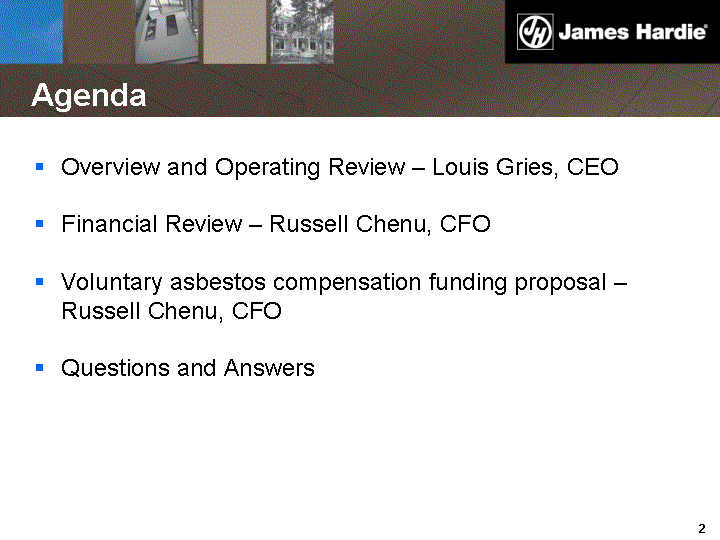
| Overview and Operating Review - Louis Gries, CEO Financial Review - Russell Chenu, CFO Voluntary asbestos compensation funding proposal - Russell Chenu, CFO Questions and Answers Agenda |
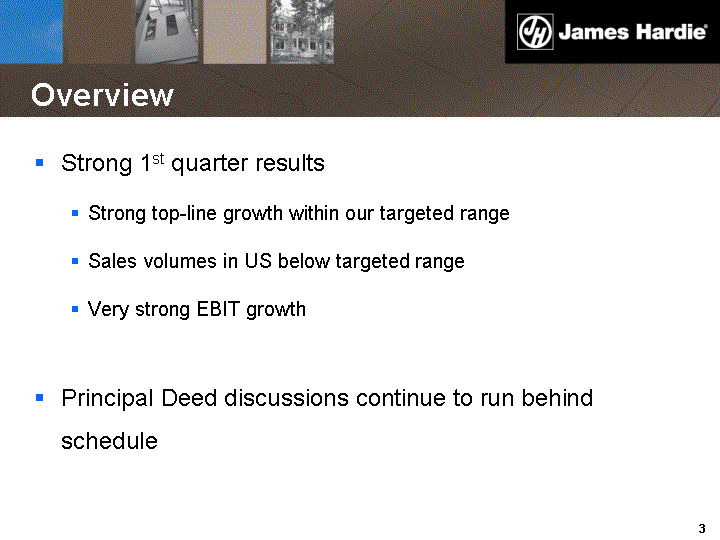
| Overview Strong 1st quarter results Strong top-line growth within our targeted range Sales volumes in US below targeted range Very strong EBIT growth Principal Deed discussions continue to run behind schedule |
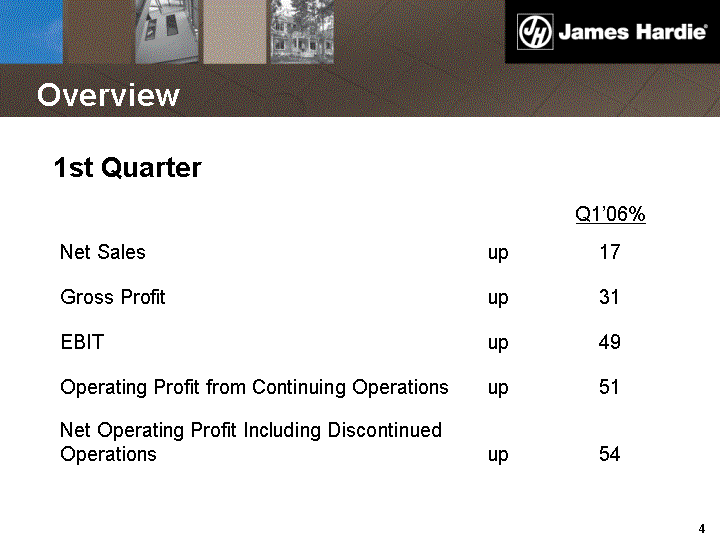
| Overview 1st Quarter Q1'06% Net Sales up 17 Gross Profit up 31 EBIT up 49 Operating Profit from Continuing Operations up 51 Net Operating Profit Including Discontinued Operations up 54 |
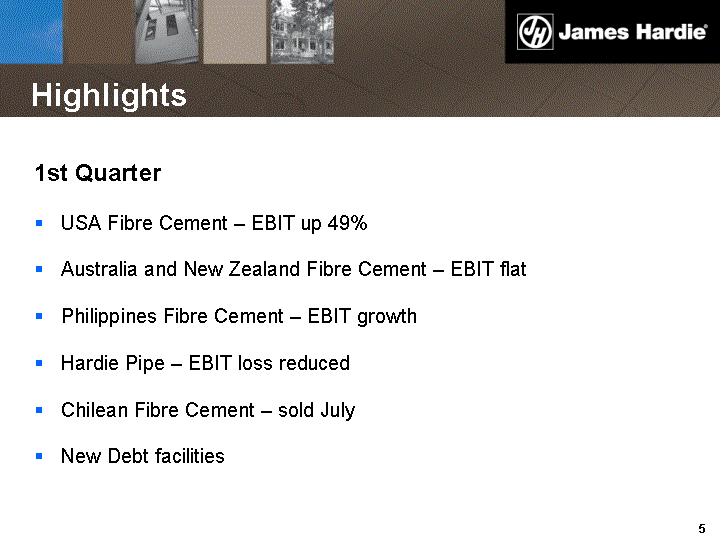
| Highlights 1st Quarter USA Fibre Cement - EBIT up 49% Australia and New Zealand Fibre Cement - EBIT flat Philippines Fibre Cement - EBIT growth Hardie Pipe - EBIT loss reduced Chilean Fibre Cement - sold July New Debt facilities |
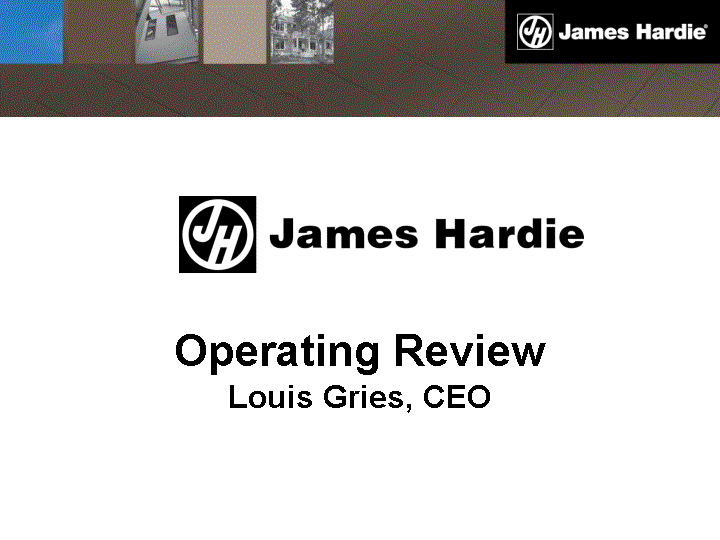
| Operating Review Louis Gries, CEO |

| USA Fibre Cement |
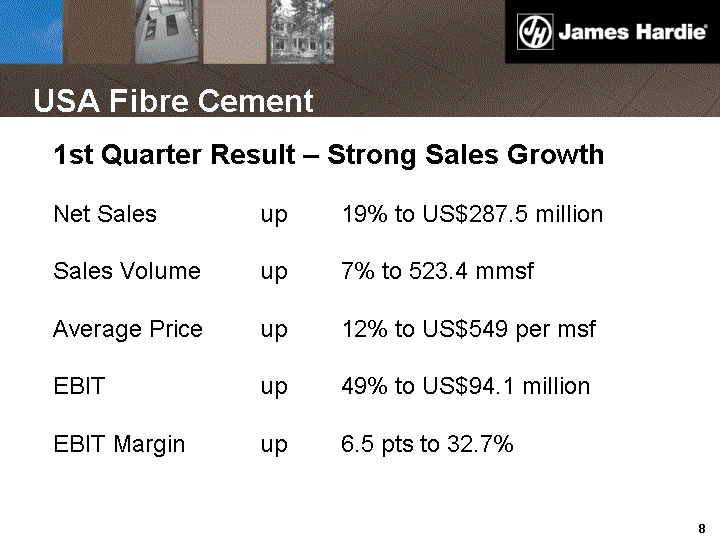
| 1st Quarter Result - Strong Sales Growth Net Sales up 19% to US$287.5 million Sales Volume up 7% to 523.4 mmsf Average Price up 12% to US$549 per msf EBIT up 49% to US$94.1 million EBIT Margin up 6.5 pts to 32.7% USA Fibre Cement |
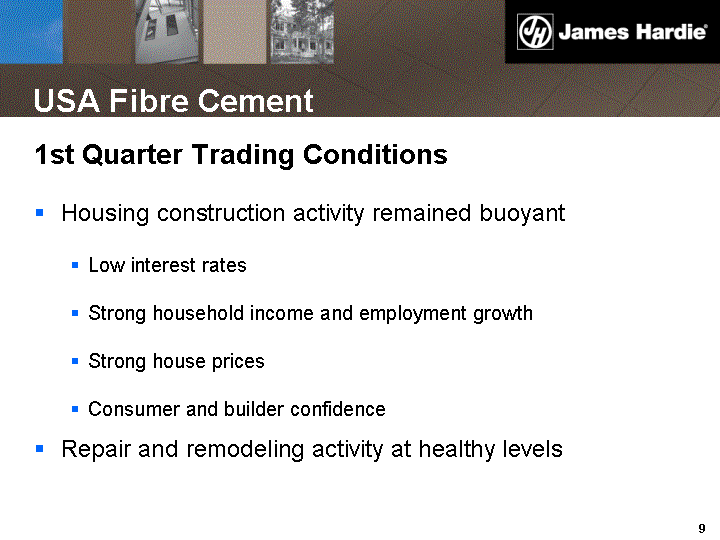
| USA Fibre Cement 1st Quarter Trading Conditions Housing construction activity remained buoyant Low interest rates Strong household income and employment growth Strong house prices Consumer and builder confidence Repair and remodeling activity at healthy levels |
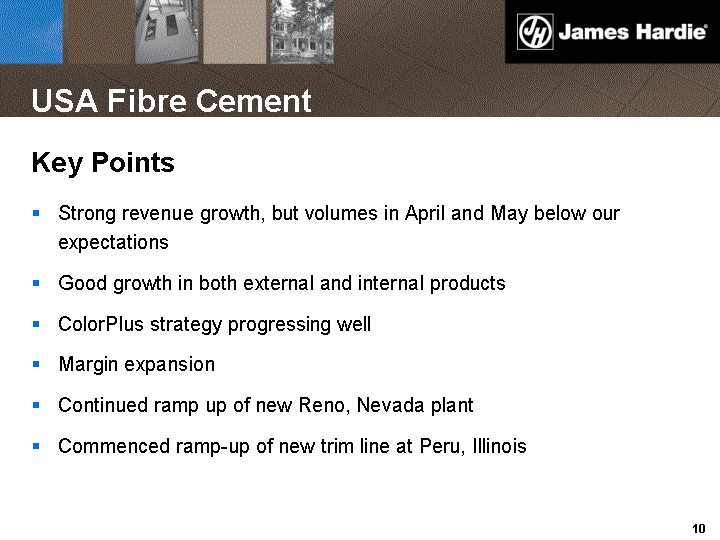
| USA Fibre Cement Key Points Strong revenue growth, but volumes in April and May below our expectations Good growth in both external and internal products ColorPlus strategy progressing well Margin expansion Continued ramp up of new Reno, Nevada plant Commenced ramp-up of new trim line at Peru, Illinois |
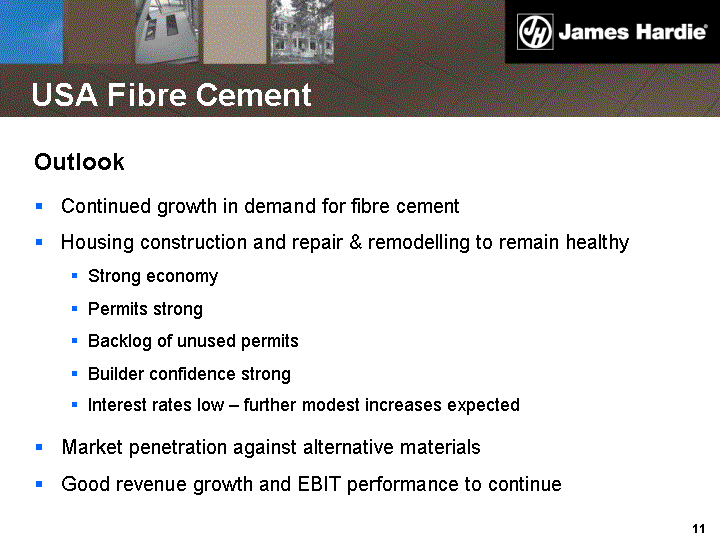
| USA Fibre Cement Outlook Continued growth in demand for fibre cement Housing construction and repair & remodelling to remain healthy Strong economy Permits strong Backlog of unused permits Builder confidence strong Interest rates low - further modest increases expected Market penetration against alternative materials Good revenue growth and EBIT performance to continue |
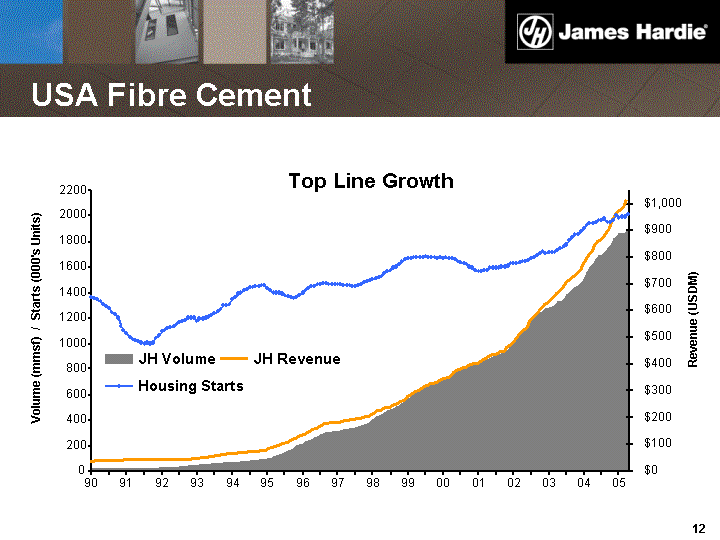
| USA Fibre Cement Top Line Growth 0 200 400 600 800 1000 1200 1400 1600 1800 2000 2200 90 91 92 93 94 95 96 97 98 99 00 01 02 03 04 05 Volume (mmsf) / Starts (000's Units) $0 $100 $200 $300 $400 $500 $600 $700 $800 $900 $1,000 Revenue (USDM) JH Volume JH Revenue Housing Starts |
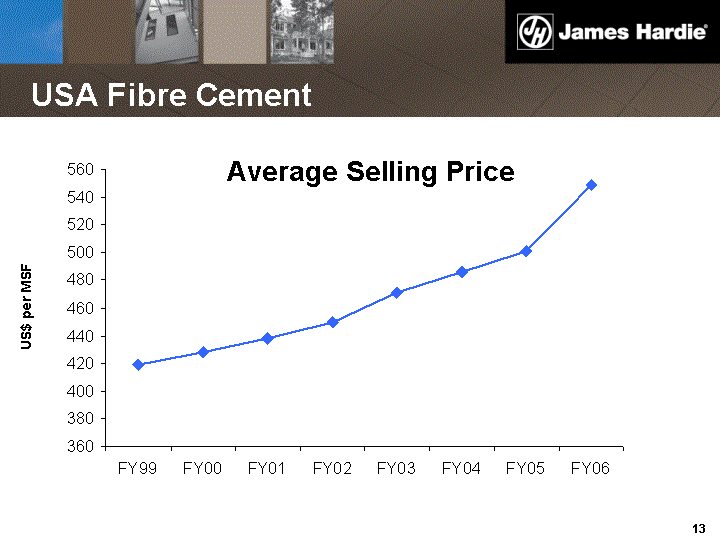
| USA Fibre Cement Average Selling Price US$ per MSF |
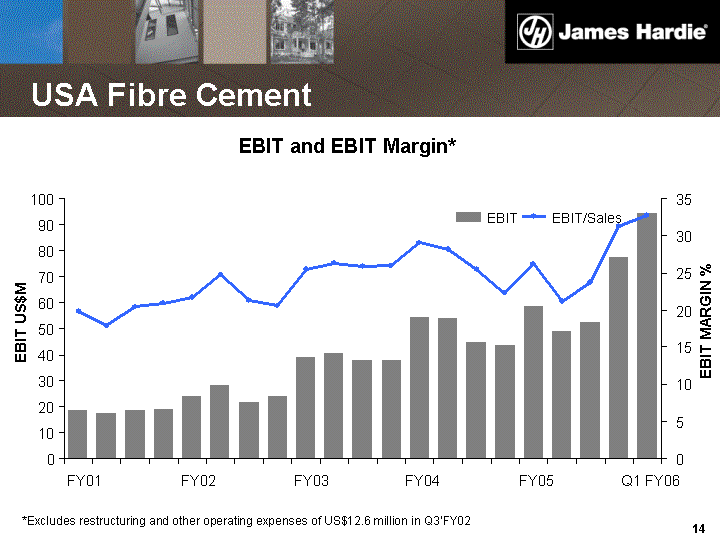
| USA Fibre Cement *Excludes restructuring and other operating expenses of US$12.6 million in Q3'FY02 EBIT and EBIT Margin* 0 10 20 30 40 50 60 70 80 90 100 FY01 FY02 FY03 FY04 FY05 Q1 FY06 EBIT US$M 0 5 10 15 20 25 30 35 EBIT MARGIN % EBIT EBIT/Sales |
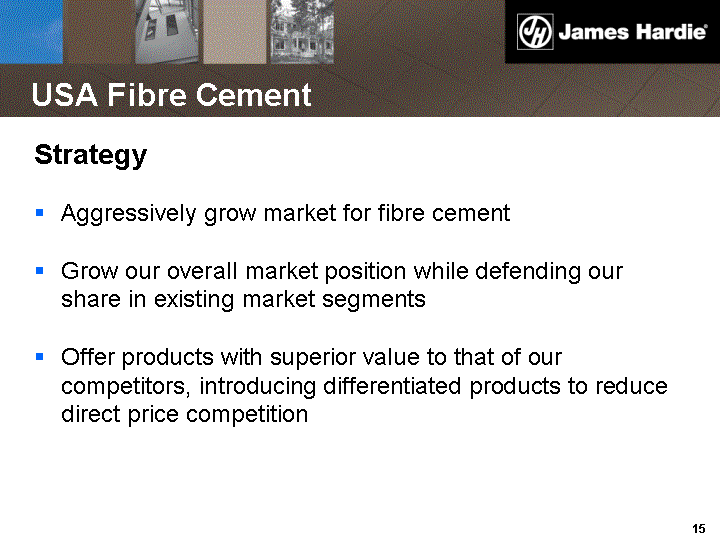
| USA Fibre Cement Strategy Aggressively grow market for fibre cement Grow our overall market position while defending our share in existing market segments Offer products with superior value to that of our competitors, introducing differentiated products to reduce direct price competition |
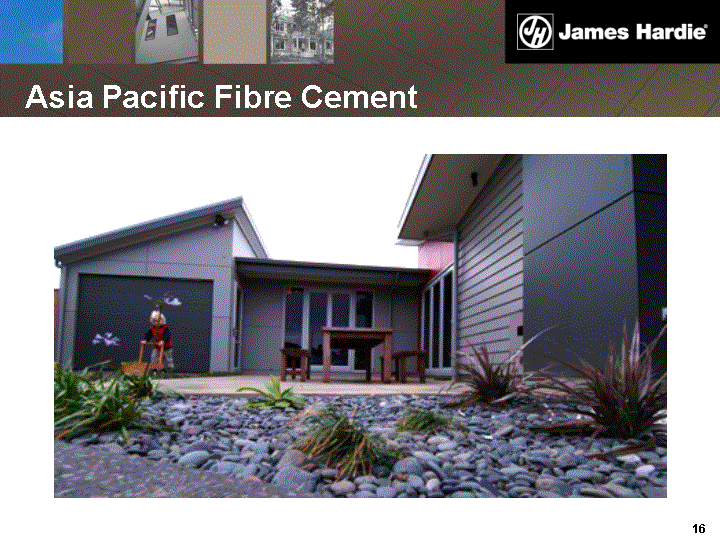
| Asia Pacific Fibre Cement |
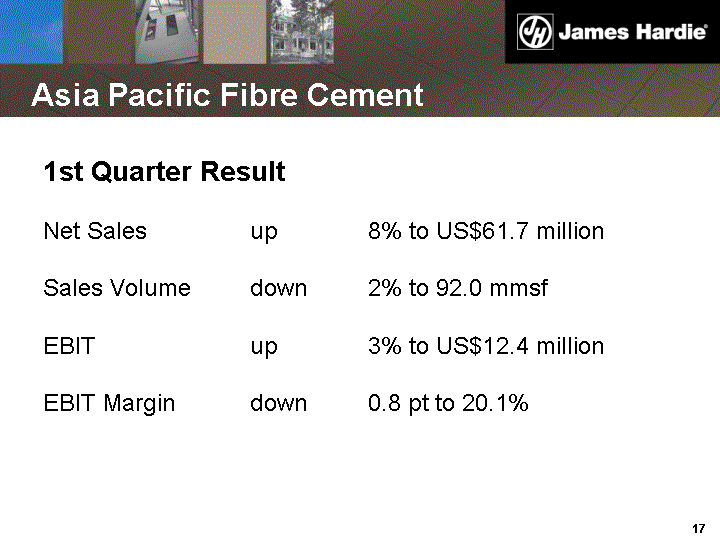
| Asia Pacific Fibre Cement 1st Quarter Result Net Sales up 8% to US$61.7 million Sales Volume down 2% to 92.0 mmsf EBIT up 3% to US$12.4 million EBIT Margin down 0.8 pt to 20.1% |
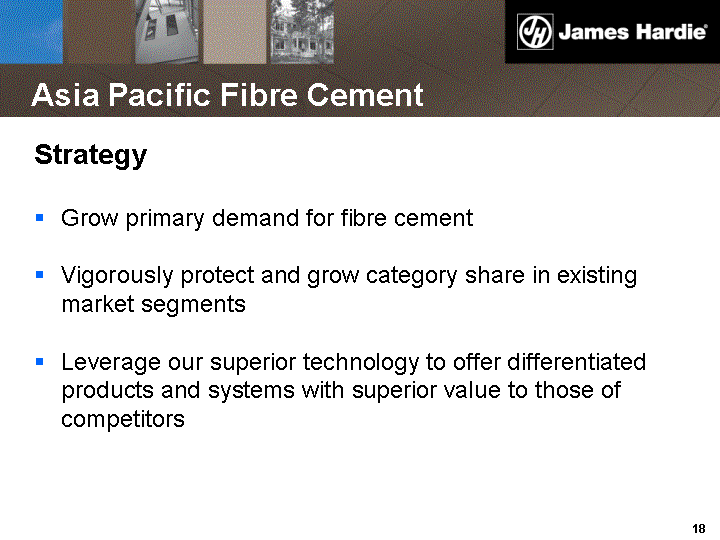
| Strategy Grow primary demand for fibre cement Vigorously protect and grow category share in existing market segments Leverage our superior technology to offer differentiated products and systems with superior value to those of competitors Asia Pacific Fibre Cement |
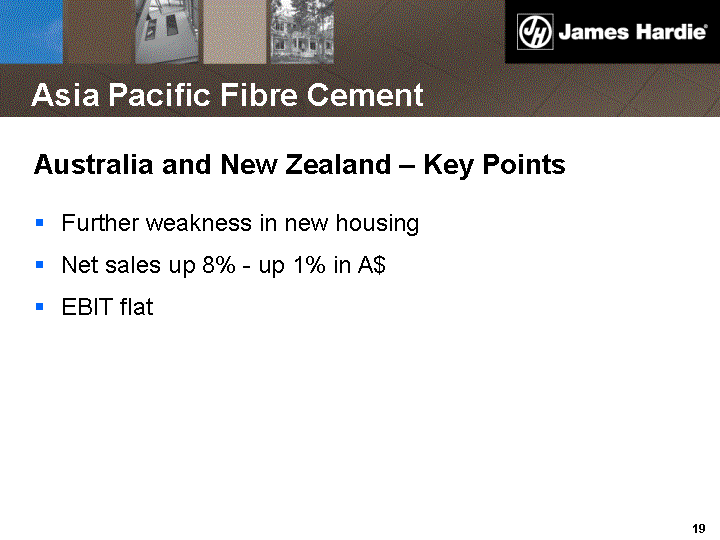
| Asia Pacific Fibre Cement Australia and New Zealand - Key Points Further weakness in new housing Net sales up 8% - up 1% in A$ EBIT flat |
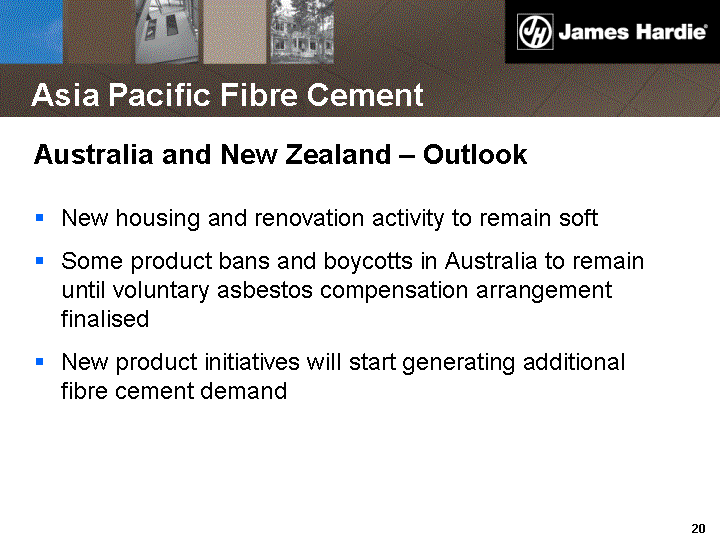
| Asia Pacific Fibre Cement Australia and New Zealand - Outlook New housing and renovation activity to remain soft Some product bans and boycotts in Australia to remain until voluntary asbestos compensation arrangement finalised New product initiatives will start generating additional fibre cement demand |
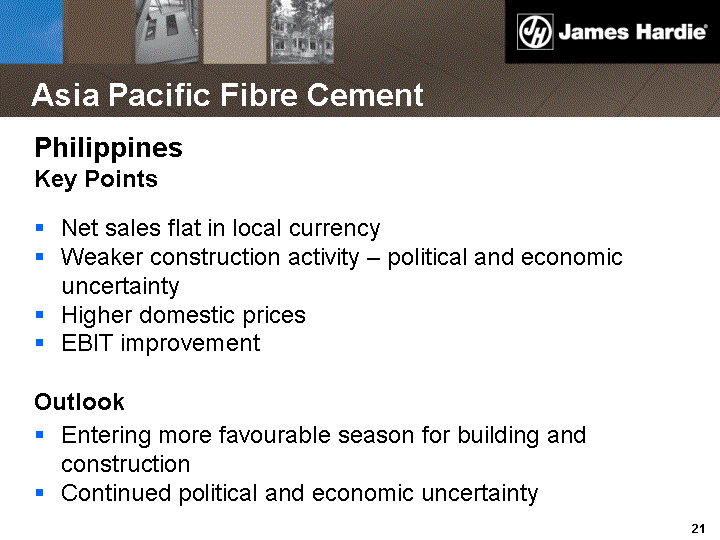
| Asia Pacific Fibre Cement Philippines Key Points Net sales flat in local currency Weaker construction activity - political and economic uncertainty Higher domestic prices EBIT improvement Outlook Entering more favourable season for building and construction Continued political and economic uncertainty |
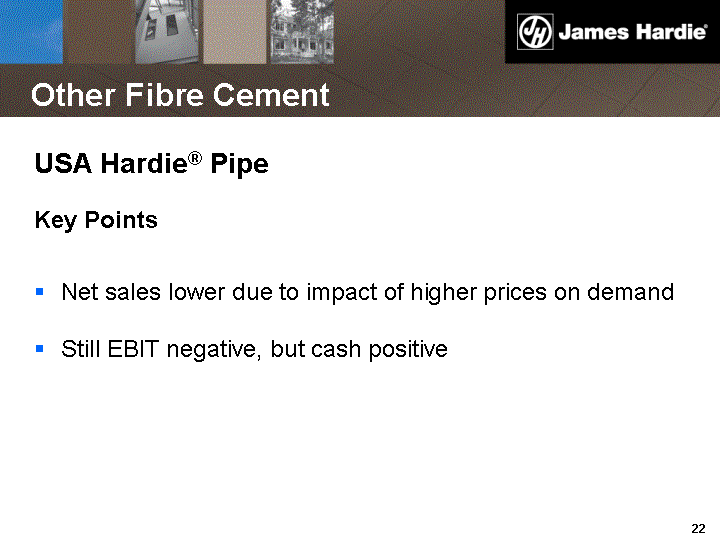
| Other Fibre Cement USA Hardie(r) Pipe Key Points Net sales lower due to impact of higher prices on demand Still EBIT negative, but cash positive |
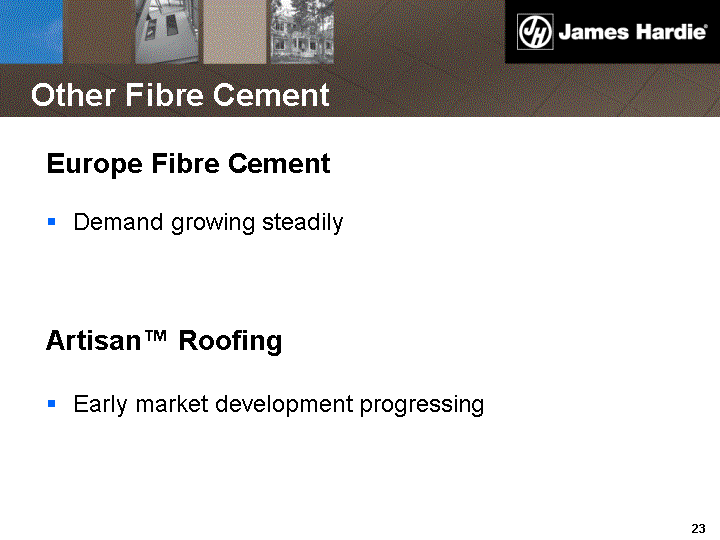
| Other Fibre Cement Europe Fibre Cement Demand growing steadily Artisan(tm) Roofing Early market development progressing |
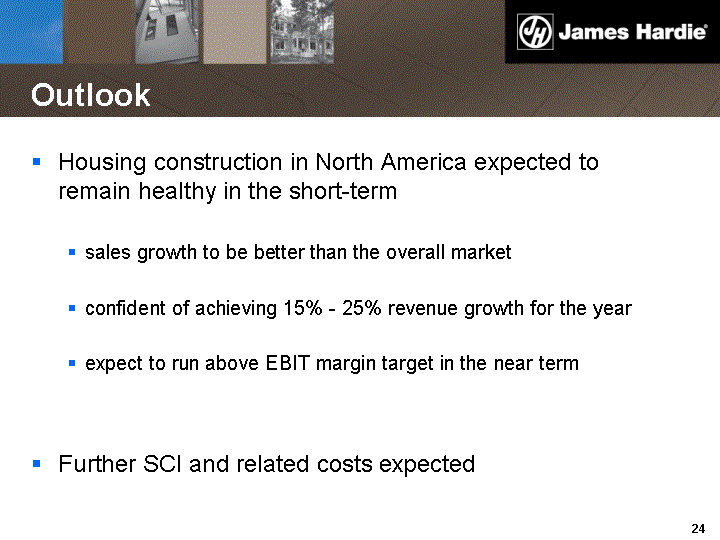
| Outlook Housing construction in North America expected to remain healthy in the short-term sales growth to be better than the overall market confident of achieving 15% - 25% revenue growth for the year expect to run above EBIT margin target in the near term Further SCI and related costs expected |
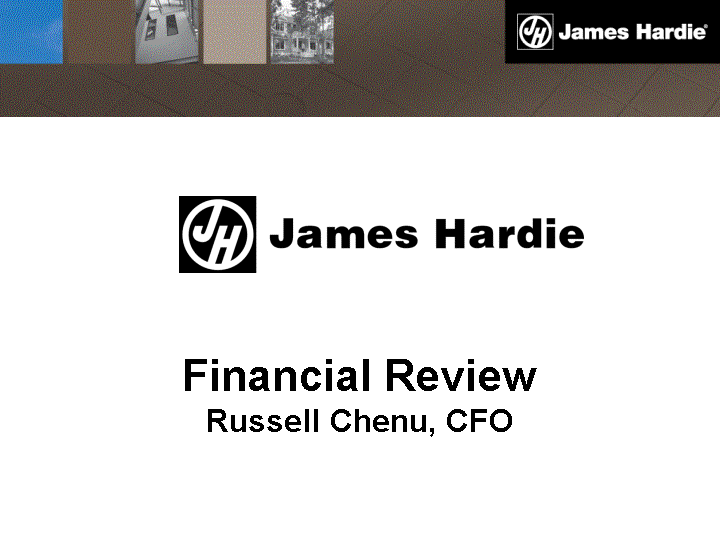
| Financial Review Russell Chenu, CFO |
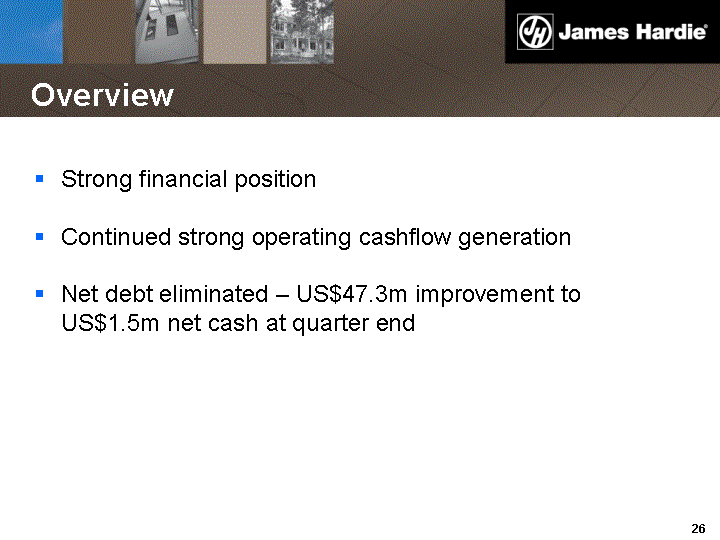
| Overview Strong financial position Continued strong operating cashflow generation Net debt eliminated - US$47.3m improvement to US$1.5m net cash at quarter end |

| US$ Million Q1'06 Q1'05 % Change Net sales 359.4 306.1 17 Gross profit 145.3 111.3 31 SG&A expenses (45.5) (45.1) 1 Research & development expenses (6.3) (5.0) 26 SCI and other related expenses (5.2) (2.9) 79 Impairment loss on business held for sale (1.4) - - EBIT 86.9 58.3 49 Net interest expense (0.7) (2.5) (72) Income tax expense (30.3) (18.7) 62 Operating profit from continuing operations 55.9 37.1 51 Results - Q1 |
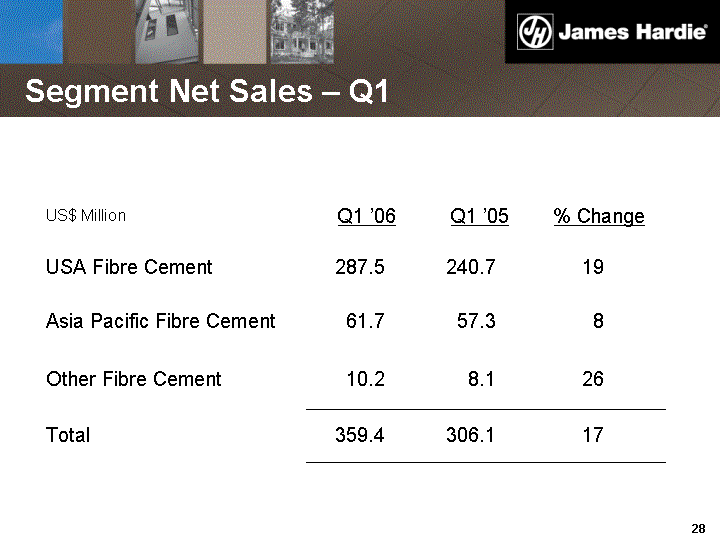
| Segment Net Sales - Q1 US$ Million Q1 '06 Q1 '05 % Change USA Fibre Cement 287.5 240.7 19 Asia Pacific Fibre Cement 61.7 57.3 8 Other Fibre Cement 10.2 8.1 26 Total 359.4 306.1 17 |
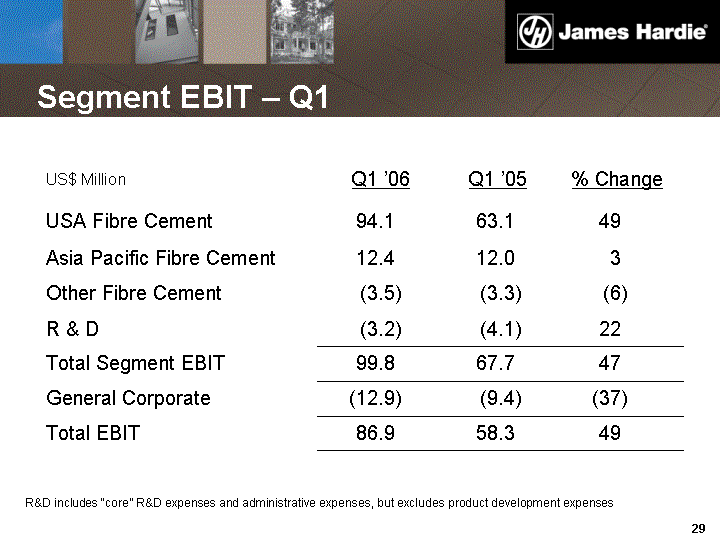
| Segment EBIT - Q1 US$ Million Q1 '06 Q1 '05 % Change USA Fibre Cement 94.1 63.1 49 Asia Pacific Fibre Cement 12.4 12.0 3 Other Fibre Cement (3.5) (3.3) (6) R & D (3.2) (4.1) 22 Total Segment EBIT 99.8 67.7 47 General Corporate (12.9) (9.4) (37) Total EBIT 86.9 58.3 49 R&D includes "core" R&D expenses and administrative expenses, but excludes product development expenses |
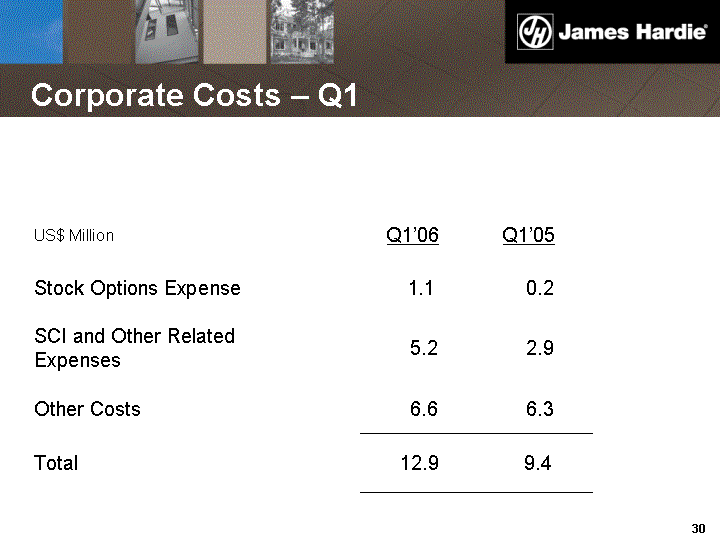
| Corporate Costs - Q1 US$ Million Q1'06 Q1'05 Stock Options Expense 1.1 0.2 SCI and Other Related Expenses 5.2 2.9 Other Costs 6.6 6.3 Total 12.9 9.4 |
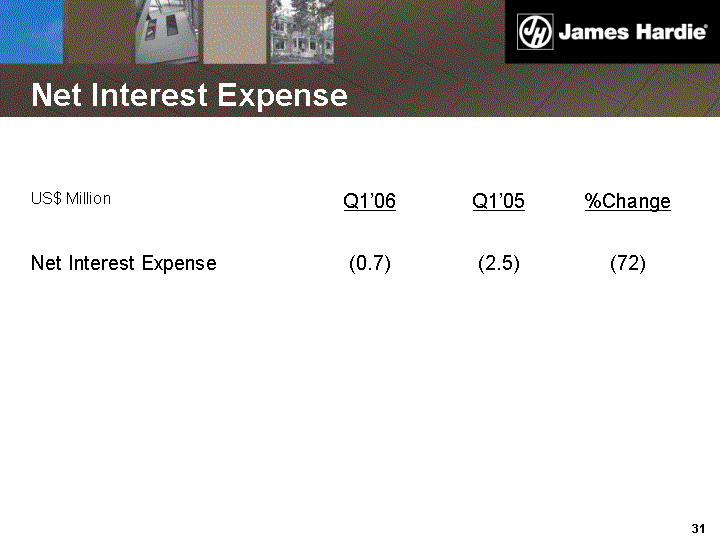
| Net Interest Expense US$ Million Q1'06 Q1'05 %Change Net Interest Expense (0.7) (2.5) (72) |
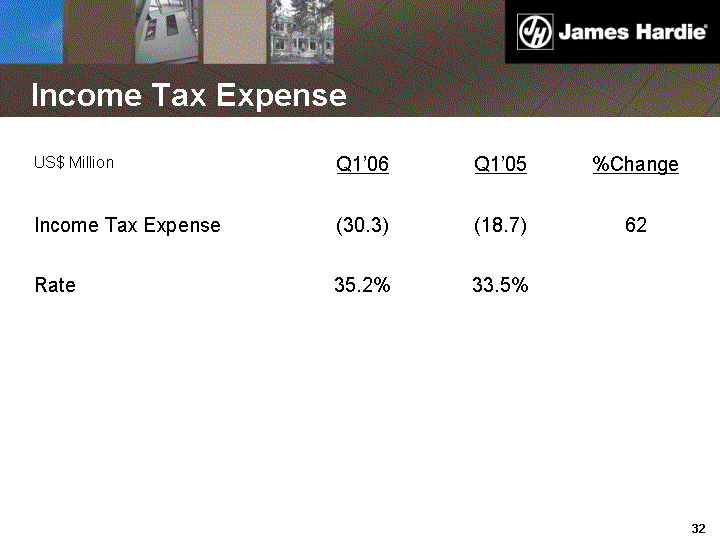
| Income Tax Expense US$ Million Q1'06 Q1'05 %Change Income Tax Expense (30.3) (18.7) 62 Rate 35.2% 33.5% |

| EBITDA - Q1 Q1'06 Q1'05 %Change EBIT USA Fibre Cement Asia Pacific Fibre Cement Other Fibre Cement R & D General Corporate 94.1 12.4 (3.5) (3.2) (12.9) 63.1 12.0 (3.3) (4.1) (9.4) 49 3 (6) 22 (37) Depreciation and Amortisation USA Fibre Cement Asia Pacific Fibre Cement Other 6.1 2.5 0.8 5.8 2.4 0.7 5 4 14 Total EBITDA 96.3 67.2 43 Net cash provided by operating activities 77.2 71.0 9 R&D includes "core" R&D expenses and administrative expenses, but excludes product development expenses Other Depreciation and Amortisation includes Other Fibre Cement, R & D and General Corporate |
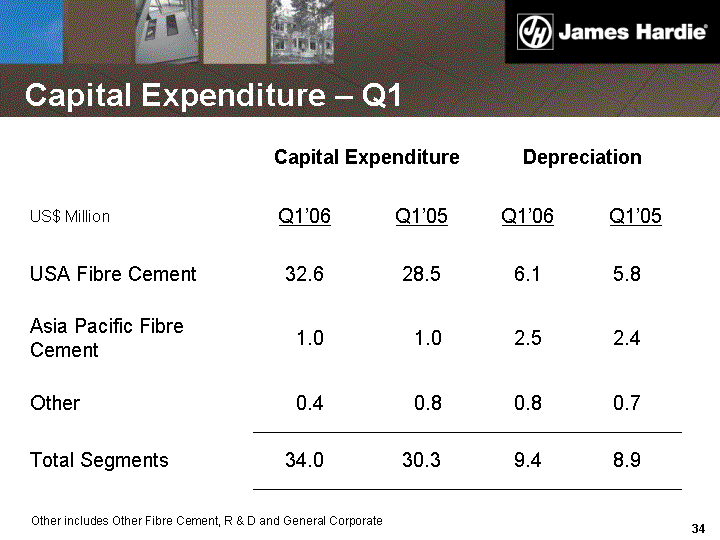
| Capital Expenditure - Q1 Capital Expenditure Capital Expenditure Depreciation Depreciation US$ Million Q1'06 Q1'05 Q1'06 Q1'05 USA Fibre Cement 32.6 28.5 6.1 5.8 Asia Pacific Fibre Cement 1.0 1.0 2.5 2.4 Other 0.4 0.8 0.8 0.7 Total Segments 34.0 30.3 9.4 8.9 Other includes Other Fibre Cement, R & D and General Corporate |
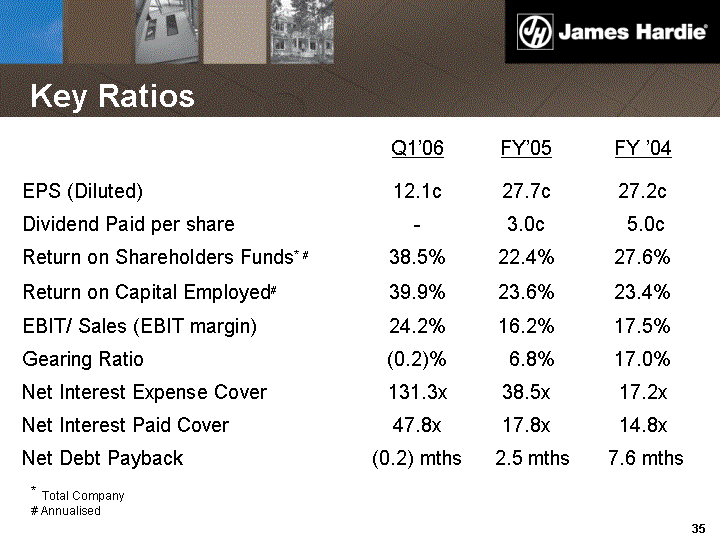
| Key Ratios Q1'06 FY'05 FY '04 EPS (Diluted) 12.1c 27.7c 27.2c Dividend Paid per share - 3.0c 5.0c Return on Shareholders Funds* # 38.5% 22.4% 27.6% Return on Capital Employed# 39.9% 23.6% 23.4% EBIT/ Sales (EBIT margin) 24.2% 16.2% 17.5% Gearing Ratio (0.2)% 6.8% 17.0% Net Interest Expense Cover 131.3x 38.5x 17.2x Net Interest Paid Cover 47.8x 17.8x 14.8x Net Debt Payback (0.2) mths 2.5 mths 7.6 mths * Total Company # Annualised |
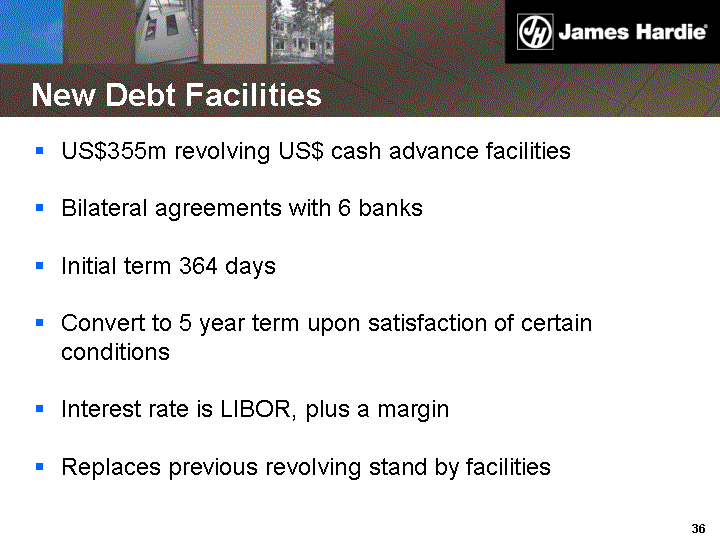
| New Debt Facilities US$355m revolving US$ cash advance facilities Bilateral agreements with 6 banks Initial term 364 days Convert to 5 year term upon satisfaction of certain conditions Interest rate is LIBOR, plus a margin Replaces previous revolving stand by facilities |
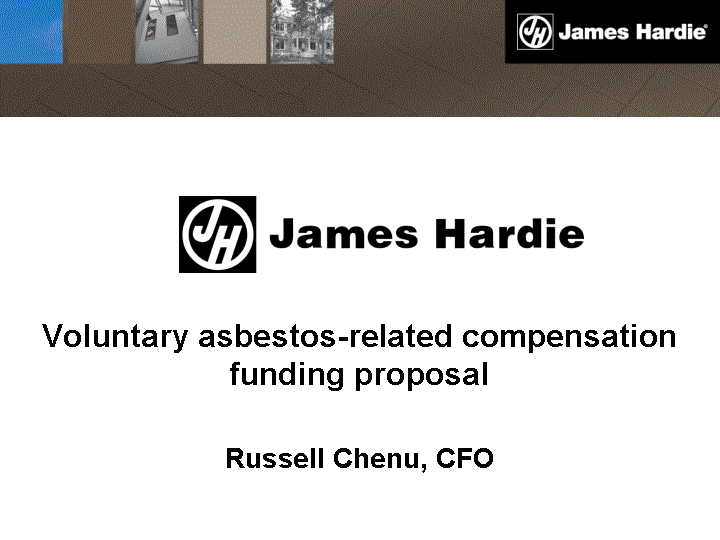
| Voluntary asbestos-related compensation funding proposal Russell Chenu, CFO |

| Voluntary Asbestos Compensation Funding Proposal Update Difficult to estimate date for signing Principal Deed and shareholder meeting Some points of difference in Principal Deed discussions remain - negotiations continuing Continuing to discuss tax deductibility of payments to Special Purpose Fund with Australian Taxation Office and Federal Treasury KPMG Actuaries updating estimate of liabilities as at 30 June 2005 Includes estimate for legal and administrative savings No provision for asbestos liability in accounts before SFAS 5 definitions of probable and estimable are satisfied |
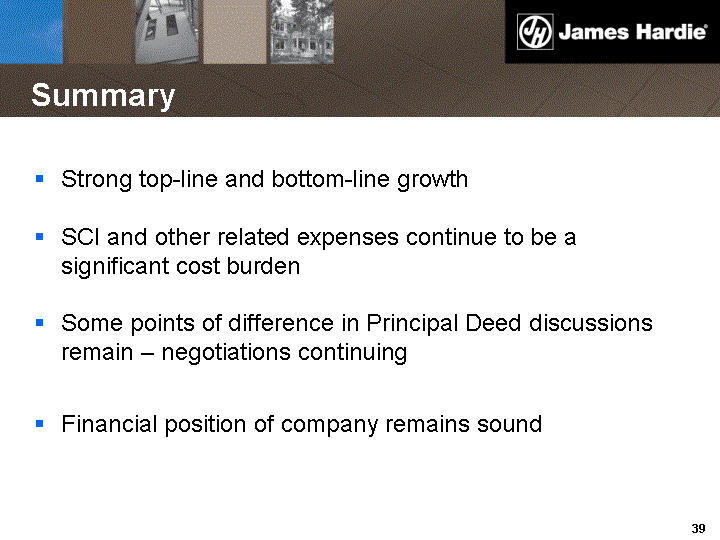
| Summary Strong top-line and bottom-line growth SCI and other related expenses continue to be a significant cost burden Some points of difference in Principal Deed discussions remain - negotiations continuing Financial position of company remains sound |

| Questions & Answers |
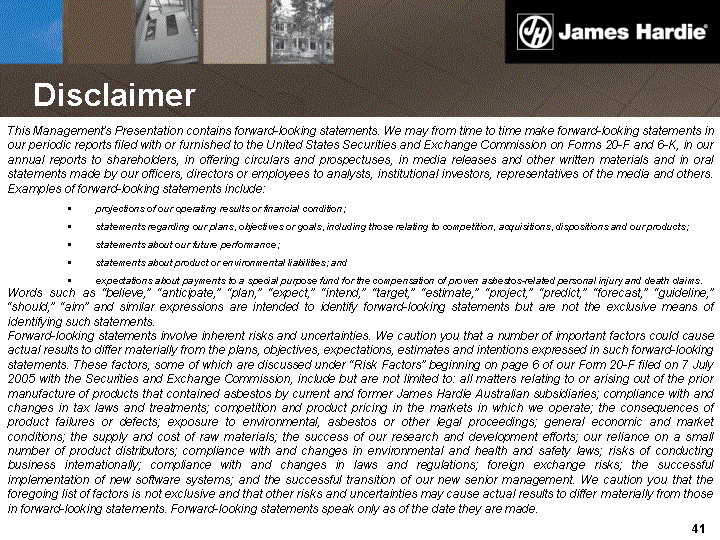
| Disclaimer This Management's Presentation contains forward-looking statements. We may from time to time make forward-looking statements in our periodic reports filed with or furnished to the United States Securities and Exchange Commission on Forms 20-F and 6-K, in our annual reports to shareholders, in offering circulars and prospectuses, in media releases and other written materials and in oral statements made by our officers, directors or employees to analysts, institutional investors, representatives of the media and others. Examples of forward-looking statements include: projections of our operating results or financial condition; statements regarding our plans, objectives or goals, including those relating to competition, acquisitions, dispositions and our products; statements about our future performance; statements about product or environmental liabilities; and expectations about payments to a special purpose fund for the compensation of proven asbestos-related personal injury and death claims. Words such as "believe," "anticipate," "plan," "expect," "intend," "target," "estimate," "project," "predict," "forecast," "guideline," "should," "aim" and similar expressions are intended to identify forward-looking statements but are not the exclusive means of identifying such statements. Forward-looking statements involve inherent risks and uncertainties. We caution you that a number of important factors could cause actual results to differ materially from the plans, objectives, expectations, estimates and intentions expressed in such forward-looking statements. These factors, some of which are discussed under "Risk Factors" beginning on page 6 of our Form 20-F filed on 7 July 2005 with the Securities and Exchange Commission, include but are not limited to: all matters relating to or arising out of the prior manufacture of products that contained asbestos by current and former James Hardie Australian subsidiaries; compliance with and changes in tax laws and treatments; competition and product pricing in the markets in which we operate; the consequences of product failures or defects; exposure to environmental, asbestos or other legal proceedings; general economic and market conditions; the supply and cost of raw materials; the success of our research and development efforts; our reliance on a small number of product distributors; compliance with and changes in environmental and health and safety laws; risks of conducting business internationally; compliance with and changes in laws and regulations; foreign exchange risks; the successful implementation of new software systems; and the successful transition of our new senior management. We caution you that the foregoing list of factors is not exclusive and that other risks and uncertainties may cause actual results to differ materially from those in forward-looking statements. Forward-looking statements speak only as of the date they are made. |
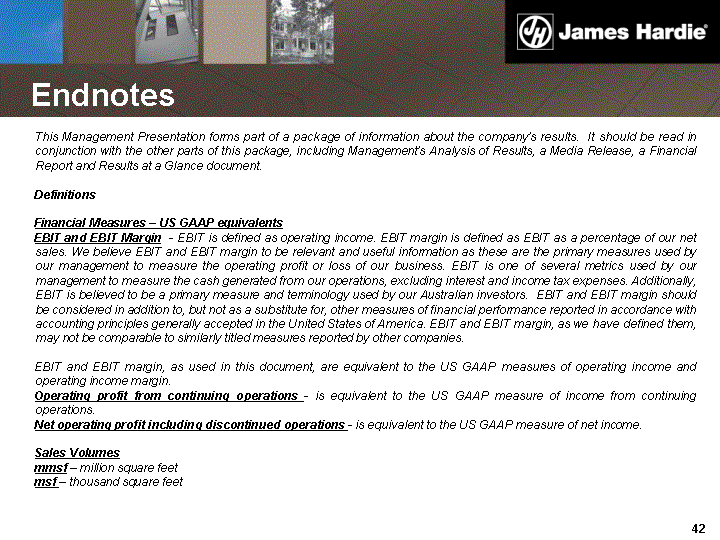
| Endnotes This Management Presentation forms part of a package of information about the company's results. It should be read in conjunction with the other parts of this package, including Management's Analysis of Results, a Media Release, a Financial Report and Results at a Glance document. Definitions Financial Measures - US GAAP equivalents EBIT and EBIT Margin - EBIT is defined as operating income. EBIT margin is defined as EBIT as a percentage of our net sales. We believe EBIT and EBIT margin to be relevant and useful information as these are the primary measures used by our management to measure the operating profit or loss of our business. EBIT is one of several metrics used by our management to measure the cash generated from our operations, excluding interest and income tax expenses. Additionally, EBIT is believed to be a primary measure and terminology used by our Australian investors. EBIT and EBIT margin should be considered in addition to, but not as a substitute for, other measures of financial performance reported in accordance with accounting principles generally accepted in the United States of America. EBIT and EBIT margin, as we have defined them, may not be comparable to similarly titled measures reported by other companies. EBIT and EBIT margin, as used in this document, are equivalent to the US GAAP measures of operating income and operating income margin. Operating profit from continuing operations - is equivalent to the US GAAP measure of income from continuing operations. Net operating profit including discontinued operations - is equivalent to the US GAAP measure of net income. Sales Volumes mmsf - million square feet msf - thousand square feet |
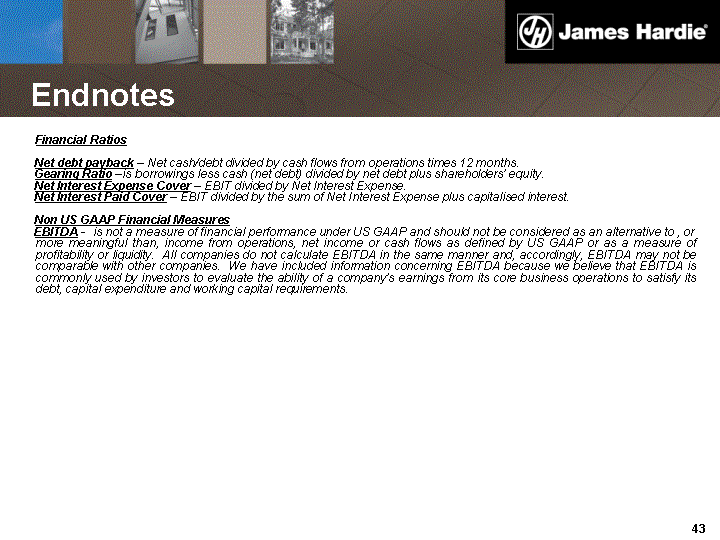
| Endnotes Financial Ratios Net debt payback - Net cash/debt divided by cash flows from operations times 12 months. Gearing Ratio -is borrowings less cash (net debt) divided by net debt plus shareholders' equity. Net Interest Expense Cover - EBIT divided by Net Interest Expense. Net Interest Paid Cover - EBIT divided by the sum of Net Interest Expense plus capitalised interest. Non US GAAP Financial Measures EBITDA - is not a measure of financial performance under US GAAP and should not be considered as an alternative to , or more meaningful than, income from operations, net income or cash flows as defined by US GAAP or as a measure of profitability or liquidity. All companies do not calculate EBITDA in the same manner and, accordingly, EBITDA may not be comparable with other companies. We have included information concerning EBITDA because we believe that EBITDA is commonly used by investors to evaluate the ability of a company's earnings from its core business operations to satisfy its debt, capital expenditure and working capital requirements. |
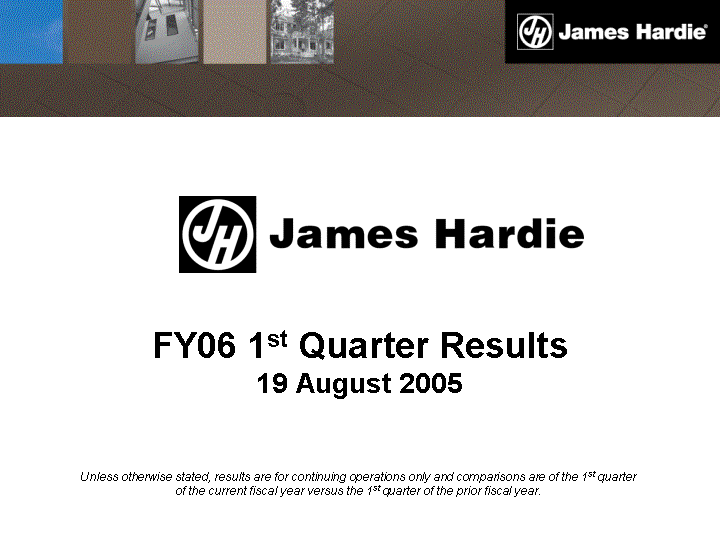
| FY06 1st Quarter Results 19 August 2005 Unless otherwise stated, results are for continuing operations only and comparisons are of the 1st quarter of the current fiscal year versus the 1st quarter of the prior fiscal year. |